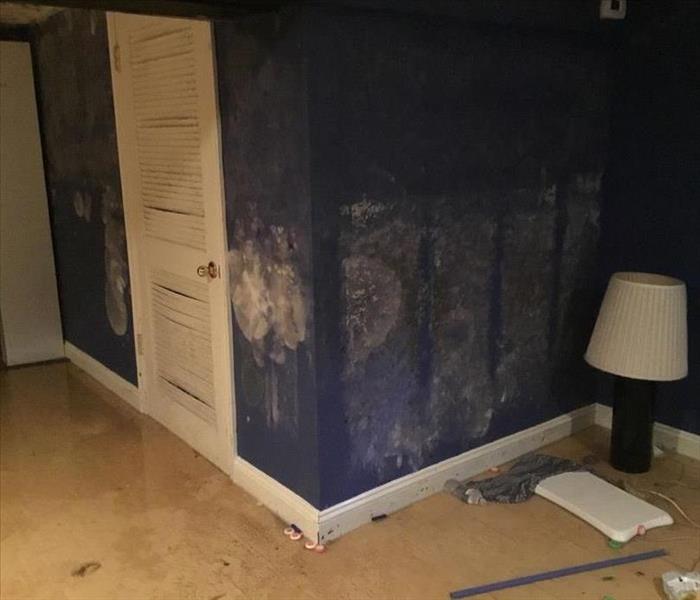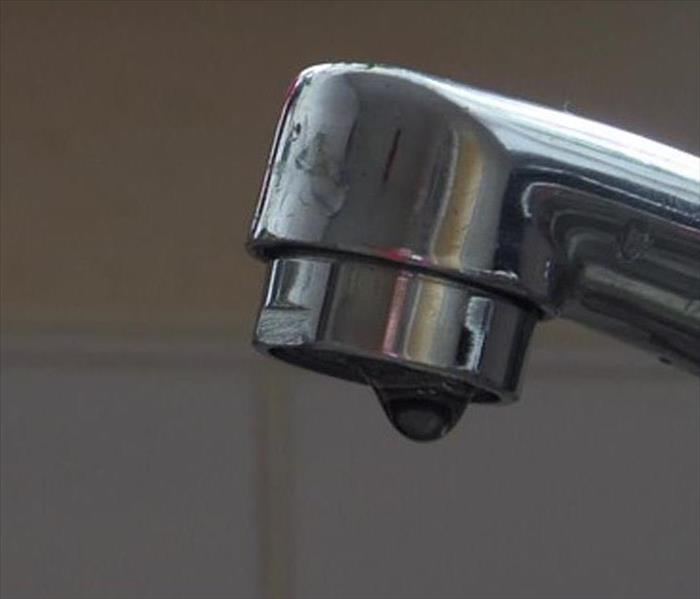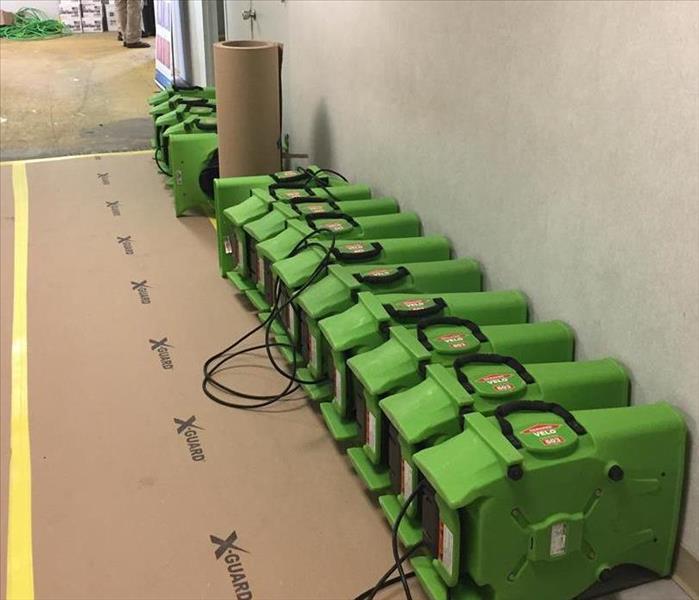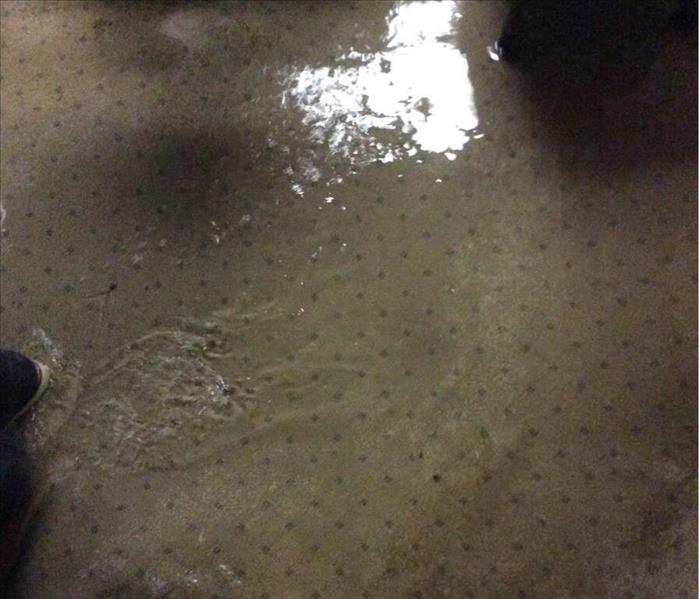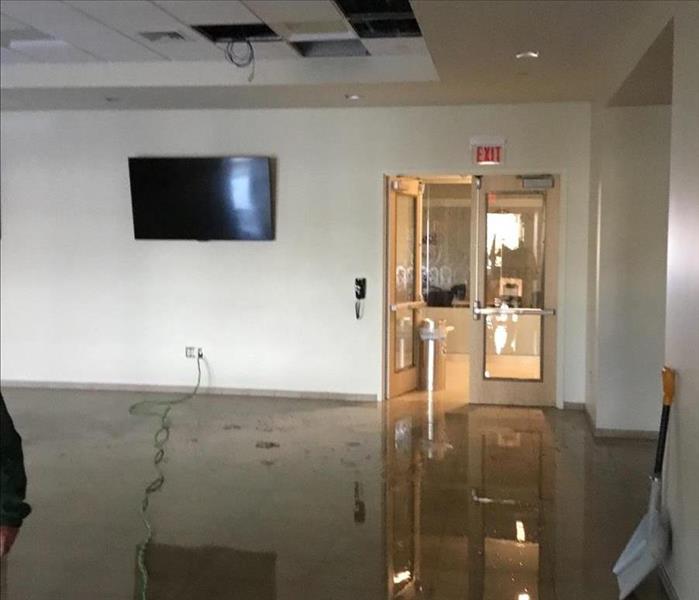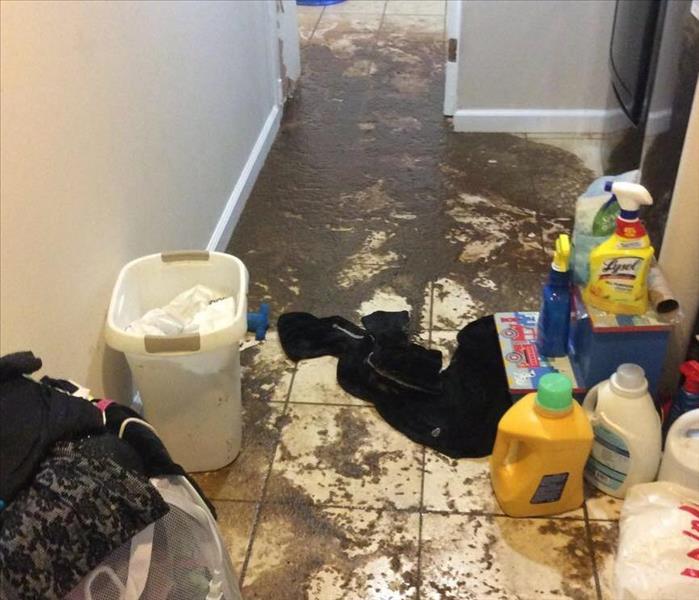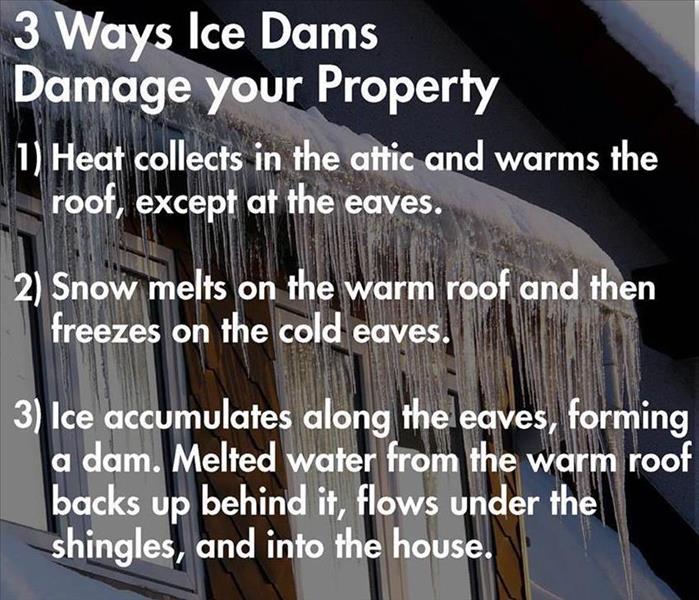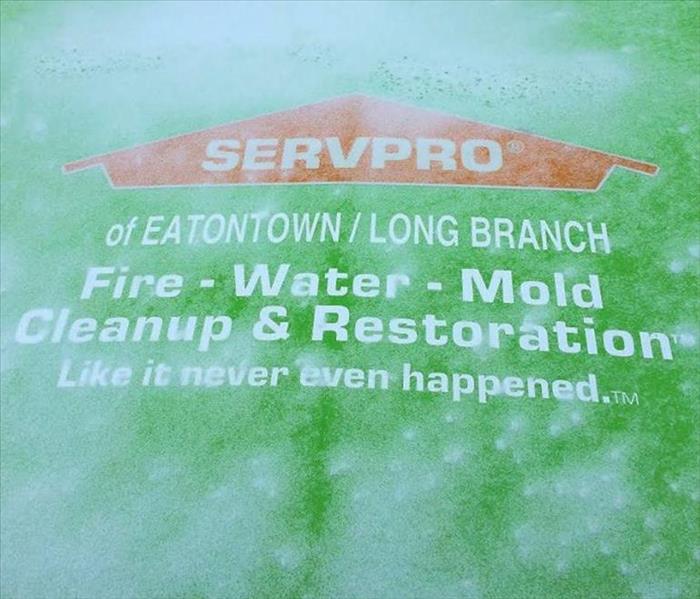Archived Water Damage Blog Posts
SERVPRO Team Majeski: Experts in Water Damage Restoration
12/15/2024 (Permalink)
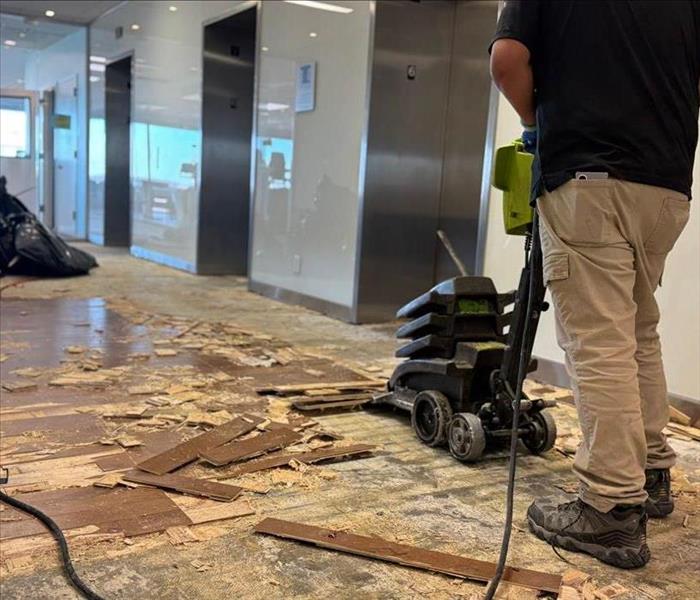 worker cutting floor tiles
worker cutting floor tiles
When water damage strikes—whether it's a small leak or a massive flood—time is of the essence. SERVPRO® Team Majeski is here to handle it all, from minor residential damages to large commercial disasters. Our trained professionals bring the expertise, tools, and determination to restore your property to its original state, making it “Like it never even happened.”
In our latest commercial restoration project, our crew took on a large-loss water damage job, performing flood cuts and flooring removal with precision and care. These steps are critical for removing water-damaged materials and preventing long-term issues like mold growth.
With advanced equipment and techniques, we ensure your property is thoroughly dried and restored, minimizing downtime and disruption. From homes to businesses, our team is ready 24/7 to respond and make things right.
Need expert water damage restoration? Call SERVPRO Team Majeski today!
Safeguarding Unaffected Areas
9/3/2024 (Permalink)
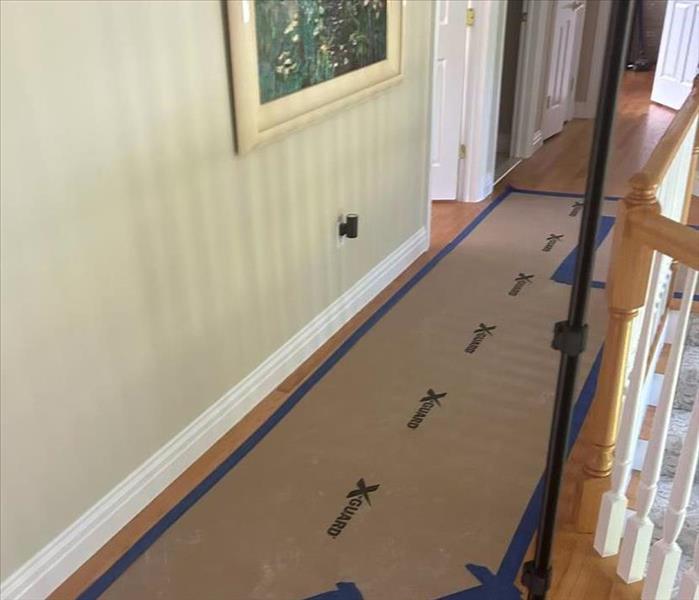 hallway wood floor protected with blue tape and plastic
hallway wood floor protected with blue tape and plastic
When water damage impacts your home, protecting the unaffected areas is just as important as addressing the damage itself. At SERVPRO Team Majeski, we take every precaution to safeguard the rest of your property, ensuring that damage is contained and your home stays safe. Our team is equipped with the expertise and technology to mitigate further harm and restore your peace of mind.
Don't let water damage spread—contact SERVPRO Team Majeski today at 732-578-9888. We're Here to Help® you protect your home and restore it "Like it never even happened."
Thawing the Freeze: A Guide to Preventing and Dealing with Frozen Pipes
12/14/2023 (Permalink)
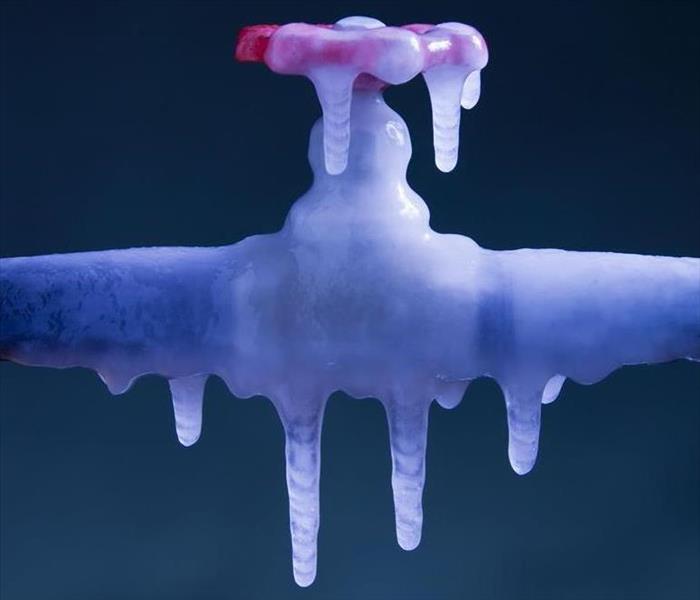 a frozen pipe faucet leak that is frozen
a frozen pipe faucet leak that is frozen
Thawing the Freeze: A Guide to Preventing and Dealing with Frozen Pipes
Meet the winter challenge head-on by safeguarding your property against frozen pipes and the potential damage they bring. As temperatures plummet, homes and businesses face the risk of leaks, flooding, and even mold. To ensure your water pipes stay functional and your property remains safe, here's a comprehensive guide:
Frozen Pipes: What You Should Know
Understanding the causes is the first step in prevention. Sudden temperature drops, poor insulation, and low thermostat settings contribute to frozen pipes. The vulnerability increases in pipes running alongside exterior walls, exposed to the elements, and those in unheated spaces.
Tips to Prevent Pipes from Freezing
- Disconnect outside garden hoses and secure outdoor valves.
- Ensure your basement is heated, cover crawl space air vents, and close windows near water pipes.
- Let faucets drip slightly overnight, especially those on outside walls.
- Insulate exposed pipes and use heating tape or pipe insulation.
- Keep cabinets open to let heat reach plumbing, and install weather sealing around windows.
- Regularly check and insulate pipes in unheated areas, like garages.
- Never use antifreeze unless directed, as it can be hazardous.
Can You Thaw Frozen Pipes?
Discovering frozen pipes doesn't have to be a nightmare. Follow these steps:
- Shut off the water supply via the main valve.
- Open a faucet to encourage thawing, and apply heat using an electric heating pad, space heater, or hot towels.
- Never use open flames or kerosene for thawing.
- If in doubt or unable to thaw, call a licensed plumber.
Winter Vacation Tip: Check Your Pipes Before Heading Out
If you're escaping the cold for warmer climes, protect your home:
- Shut off water supply and consider draining the system.
- Keep the thermostat no lower than 55º Fahrenheit (12º Celsius).
- Ask a friend or neighbor to check your house regularly.
SERVPRO’s Water Damage Cleanup Process
Should water damage occur, SERVPRO®
Team Majeski is here to help with our eight-step restoration process:
- Emergency Contact
- Inspection and Water Damage Assessment
- Water Removal
- Damaged Material Removal
- Cleaning, Sanitizing, and Deodorization
- Drying
- Monitoring
- Repairs and Construction
NJ Hurricane Season: Are You Prepared for Water Damage?
9/7/2023 (Permalink)
 waves forming in ocean as a result of hurricane
waves forming in ocean as a result of hurricane
New Jersey's hurricane season typically spans from June through November, with the highest likelihood of storms occurring between August and October. While the Garden State might not be as hurricane-prone as some other coastal regions, it's essential for residents to be prepared. One of the significant risks associated with hurricanes and tropical storms is water damage to homes and businesses.
Water damage in the home often starts as a small issue that worsens over time. Problems like a leaky pipe, roof damage, or condensation may lead to extensive damage if not detected or addressed promptly. However, during hurricane season, the risks escalate, and the damage can be severe.
Here's what you need to know about preparing for water damage during NJ's hurricane season:
1. Inspect Your Property: Before hurricane season kicks into high gear, take time to inspect your property. Look for any existing issues like leaks, cracks, or damaged roofing that could be exacerbated during a storm.
2. Secure Outdoor Items: High winds can turn outdoor items into projectiles. Secure or store outdoor furniture, grills, and other loose items to prevent damage to your property or neighboring ones.
3. Check Drainage Systems: Ensure that your property's drainage systems, such as gutters and downspouts, are clear of debris and in good working order. Proper drainage can prevent water from pooling near your home's foundation.
4. Create an Emergency Kit: Assemble an emergency kit that includes essential items like bottled water, non-perishable food, flashlights, batteries, a first-aid kit, and important documents. Don't forget to include any necessary medications.
5. Develop an Evacuation Plan: Familiarize yourself with your community's evacuation routes and shelters. Have a plan in place for your family, including pets, in case you need to evacuate.
6. Consider Flood Insurance: Standard homeowners' insurance policies often don't cover flood damage. If you live in an area prone to flooding, consider purchasing flood insurance to protect your home and belongings.
7. Stay Informed: Monitor weather forecasts and stay informed about approaching storms. Sign up for emergency alerts and have a battery-powered weather radio on hand.
8. Trim Trees and Branches: Overhanging branches or weak trees can become hazards during strong winds. Trim trees and branches that could potentially damage your home or power lines.
Despite all precautions, water damage can still occur during a hurricane. If your home experiences water damage, it's crucial to act quickly to minimize further harm. Our team is available 24/7 to respond promptly and mitigate the damage, helping you get your life back to normal as soon as possible.
Don't wait until the next storm hits. Be proactive and prepared to protect your home and loved ones during New Jersey's hurricane season.
Flood Damaged Floor Repair
9/30/2022 (Permalink)
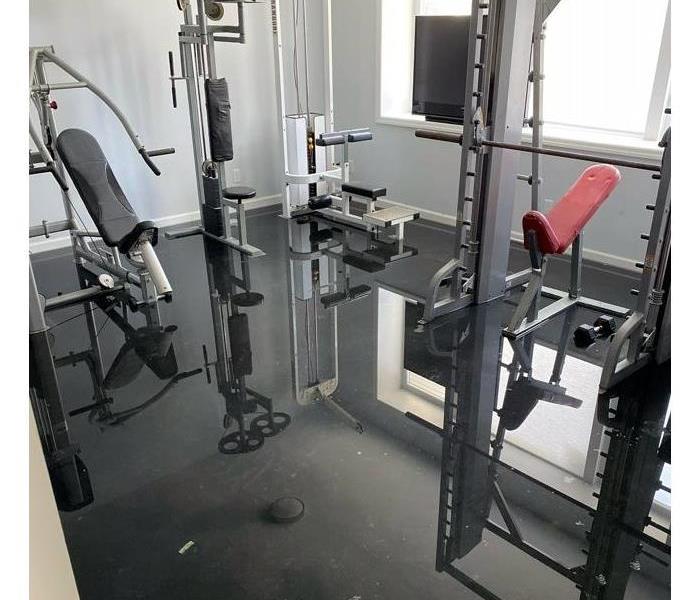 An NJ home gym flooded with water.
An NJ home gym flooded with water.
Storm surges can be dramatic and cause significant damage but with the proper tools and training, it doesn’t have to mean a total renovation. The only good thing about storm surges is that the waters often recede as quickly as they rush in. Hardwood flooring that is properly protected with polyurethane can withstand water penetration if remediation happens quickly. At SERVPRO we have the right equipment and training to often save hardwood floors instead of removing them. Here are three techniques we use.
First, our injecti-dry panel system is one way to extract moisture. Our technicians use plastic sheeting to create a containment area and install dehumidifiers to regulate the moisture levels. The panels are installed with special methods to reduce additional damage. We then use moisture measuring meters to monitor the changing moisture levels all the way to the subfloor.
Second, we may utilize a heat drying system that heats the material to approximately 100 degrees. Heat ducts are installed to remove the humid air and infrared monitors are used to monitor the drying process.
Finally, a Desiccant Dehumidifier may be used to introduce outside air which is passed through a dehumidifier before being introduced to the material. Again, moisture monitoring equipment is used to measure the progress and reduce moisture at a controlled rate.
If you experience flooded floors call us to see if one of our methods can be used to save the material before you begin removing any material.
Drying hard wood floors
5/27/2022 (Permalink)
 Water damage from the bathroom flooded this bedroom but the floor was able to be dried and did not require replacement.
Water damage from the bathroom flooded this bedroom but the floor was able to be dried and did not require replacement.
Water damage to hardwood floors can be tricky. SERVPRO has the ability and equipment to save your hardwood floors if it is addressed quickly. After our technicians have accessed the loss and determined that the hardwood floors can be saved, will set up our specialized equipment. Insurance companies and adjusters like it when we can save the floors because it is more cost-effective which in turn keeps down premiums. The floor drying mat system removes the excess water from underneath the hardwood floors. Stabilization takes between two to six days but in some cases may take longer. The goal is to remove the visible cupping and to get as close to appropriate equilibrium moisture content without overdrying. If you encounter water damage and your wood floors are affected, please call SERVPRO for a free consultation. We will respond quickly and help you with your loss and make it, “Like it never even happened.”
Cleaning a Flooded Basement
1/31/2022 (Permalink)
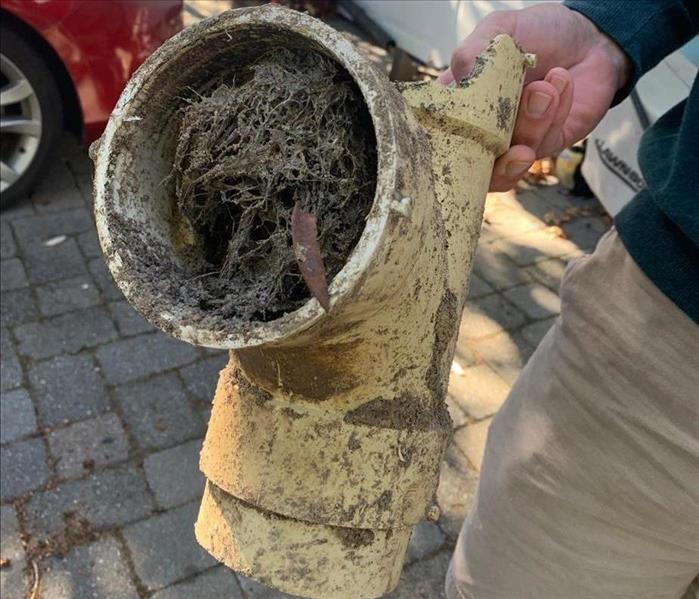 The roots of a tree clogged this pipe causing it to back up into the basement.
The roots of a tree clogged this pipe causing it to back up into the basement.
Groundwater flooding is basically water in your basement caused by seepage or flows through the walls or foundation floor.
According to State Farm Insurance, there are four common sources of water entering basements. Each source has its own specifics and requires its own course of action.
Surface water running down foundation walls.
If this is the first instance of water problems in your basement, the first thing to check for is surface water draining down next to the foundations. Water coming in at one location or only at the exterior foundation wall indicates surface water problems. Here are some things to look for once you get outside.
- Overflowing gutters: leaves
- Overflowing gutters: downspouts
- Downspout distance
- Pavement slope
- Sealant
- Landscape slope
- Irrigation
Groundwater in water-saturated soils is being pushed into the basement by hydrostatic pressure.
If no surface water sources are found, then the source of the water is likely subsurface groundwater under hydrostatic pressure. When the groundwater levels outside the basement rise above the level of the floor, the basement acts like a boat in a pond. If a boat is sitting in water, water will leak in through any open cracks or holes. It works the same way with a basement. Hydrostatic pressure can push water through hairline cracks.
Unfortunately, subsurface groundwater problems are more difficult and more expensive to fix than surface groundwater problems.
Storm sewer water from the municipal storm sewer system backing up into the home's existing perimeter foundation drain and leaking into the basement.
If you have an older house within town and the house has a basement with no sump pump, it is likely the perimeter foundation drain system connects directly into the city storm sewer system. If the level of the basement is below the street level, there is the potential of stormwater backing up in the city storm sewer system and being pushed into the perimeter foundation drain system. This can saturate the soils around the house at the basement level with stormwater under hydrostatic pressure, causing water to leak in.
- Underground springs
- Stormwater backing up
- Sewer water backing up
Sanitary sewer water from a clog in your home's sewer line. If there is a clog in the municipal sewer line, or the combined municipal storm/sanitary sewer system backing up into the home's drain system, it can cause sewer water to come up through sink drains and floor drains on lower levels.
Whatever the cause of water in your basement, remember it is important to have it dried out as soon as possible by a professional. SERVPRO of Eatontown/Long Branch is available 24/7 and will be able to get to your water damage quickly.
Training for Excellence
1/29/2022 (Permalink)
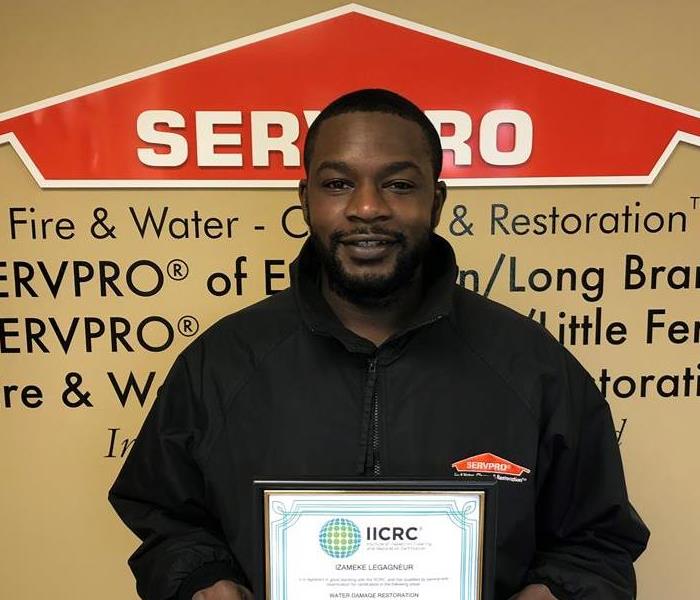 Meek holds his latest certification as a Water Damage Technician
Meek holds his latest certification as a Water Damage Technician
Congratulations to our technician, “Meek,” on completing his certification as a Water Damage Technician from the IICRC. At SERVPRO of Eatontown/Long Branch, we believe in service excellence and that begins with having professionally trained team members. We don’t hire “laborers.” We employ “Technicians” and invest in their training to tackle even the most challenging jobs professionally. This particular certification from the Institute of Inspection Cleaning and Restoration Certification is the gold standard in the restoration industry. Our team members are constantly taking courses to stay current on the latest trends, techniques, and tools of the trade.
Take a look at our reviews and you will consistently see comments about our professionalism in action. We take pride in these skills and our ability to make someone’s mess, “Like it never even happened.”
Leaking Hot Water Heater?
1/29/2022 (Permalink)
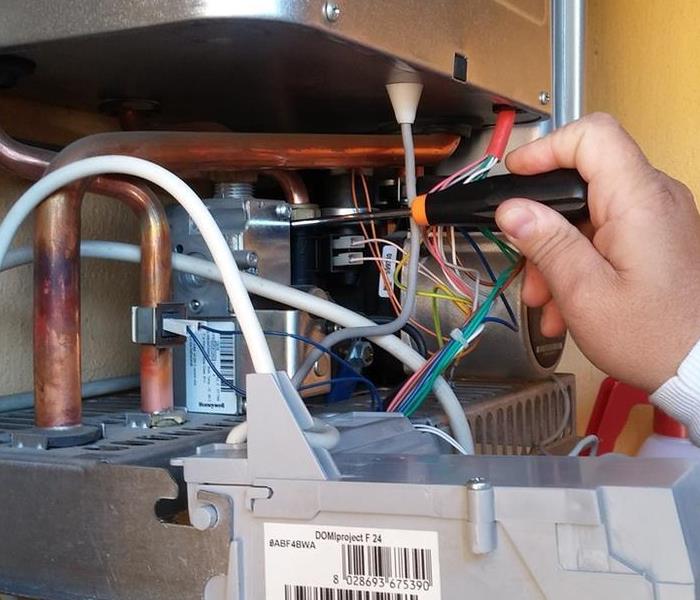 Making Adjustments to a hot water heater.
Making Adjustments to a hot water heater.
Sooner or later everyone will experience a leaking hot water heater. But this minor emergency doesn’t have to become a major disaster.
Here’s a list of steps you can take to minimize the damage from a leaking heater:
Confirm that it is, in fact, your water heater that’s leaking.
Sometimes looks can be deceiving. If you see a puddle of water under your hot water heater, it’s obvious why your first thought would be a heater leak. But that may, in fact, not be the problem.
If it’s a small puddle, your first step should be to clean up the water and inspect the heater. Do you see any wet fittings or other signs of leakage from the tank itself? Check your surroundings for other water sources? Maybe there’s a nearby window or pipe that is the actual source of the water you see. Don’t forget about the effect of gravity! If your floor slopes, the water may have traveled from a different source point to the place where it ultimately pooled.
Turn off the water.
If you do have a leaking water heater, the next recommended step is to turn off the water.
Your hot water heater should have its own shut-off valve.
If your valve is broken, you may need to shut off the water to your home. If you need assistance, reach out to your local expert professionals.
Cut the power.
Whether you have a gas or electrically powered water heater, your next step is to shut off the fuel source that powers your heater.
A gas tank should have its own dedicated shut-off gas valve. You want to make sure the gas is off so your heater will be safe to work with. If you have an electric tank, you can shut off the power at the breaker.
Try to determine the location and cause of the leak.
Now that the water and power are off, you will be in a better position to assess your situation and try to determine the location and course of your leak:
Check the pipes that connect to your heater for any loose fittings. This may just require quick tightening with a wrench.
- Check your pressure relief valve. If the temperature or pressure is too high, this could be causing valve leaks. Your water heater should be around 120 degrees Fahrenheit and the pressure shouldn’t be over 80 PSI.
- Check the drain valve to make sure it doesn’t need replacing.
- Check the bottom of the water heater itself -- it may be that the tank itself is cracked and needs to be replaced.
If you determine that it is your tank that is leaking and the leak is serious, you may want to drain the tank to minimize further water damage.
Hopefully, the leak from your hot water heater hasn’t caused too much water damage. But if you need professional assistance, the restoration pros at SERVPRO Eatontown / Long Branch are here to help. We’re equipped to handle any size water damage restoration needed for either residential or commercial buildings.
Just call us any time 24/7 at 732-578-9888
Different Types of Water Damage
1/29/2022 (Permalink)
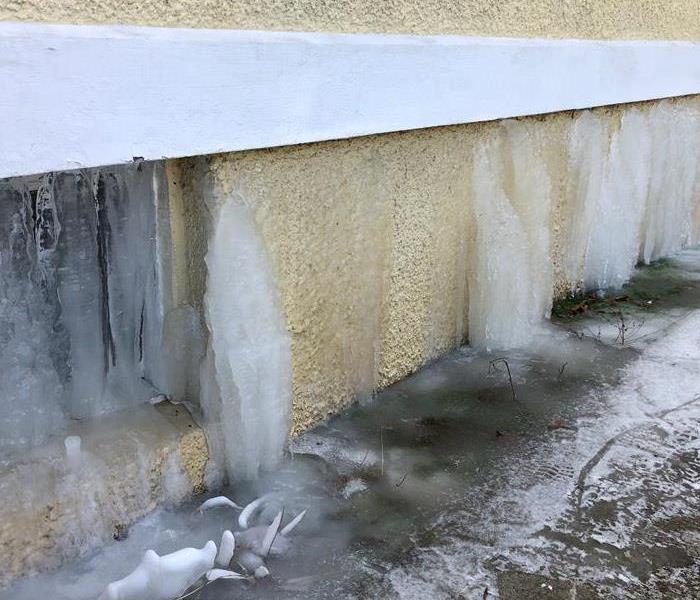 Flooding water in the home turned into icicles on the outside of the home.
Flooding water in the home turned into icicles on the outside of the home.
According to Wikipedia, wastewater is any water that has been affected by human use. But did you know that there are different grades of wastewater? Should your home be affected by water damage, it is imperative to act quickly to mitigate damage and prevent further damage such as mold growth.
CLEAN WATER
Floodwater that does not pose an immediate health threat is known as clean water. Clean water floods can result from malfunctioning appliances, toilet holding tanks, and melting snow and rainwater. Clean water home floods are generally safe for you to clean up yourself, but remember--time is an important factor. Standing clean water can become greywater if left untreated.
GREYWATER
Greywater refers to wastewater that is not contaminated with fecal matter. As far as household wastewater goes, greywater could include water from bathtubs and showers, appliances such as dishwashers, a weather event, an overflowing plumbing fixture or appliance, or even a broken pipe.
When flooding occurs, it can saturate carpeting, furniture, and drywall. If you experience a home flood with greywater, wear protective gear, and keep children and pets away from the flooded area. If the flood is extensive, such as several inches of water in the basement, it is advisable to hire professionals to safely clean up and decontaminate the area. Cleanup must begin as soon as possible as greywater can become blackwater if left untreated.
BLACKWATER
Blackwater is wastewater contaminated with human waste, floodwater, or water contaminated with chemicals.
Blackwater floods are the most dangerous and the most destructive and must be cleaned and mitigated immediately. Because of the unsanitary conditions of the water, items such as carpets, upholstery, and drywall are often unsalvageable. Contact with blackwater can cause illness in both humans and pets.
Having water damage in your home is never a pleasant experience, and oftentimes it is destructive, and disruptive - affecting multiple rooms, floors, levels – of a home, office, or multiple dwelling. Knowing whom to call and when could mean all the difference in keeping contamination and damage to a minimum.
Remember that you can call SERVPRO of Eatontown/Long Branch twenty-four hours a day, 365 days a year. We will be there to survey and clean up your water damage quickly and get you back to your normal routine as quickly as possible.
How to Handle a Leaking Toilet
10/29/2021 (Permalink)
 Animated toilet paper roll yelling, "Stop"
Animated toilet paper roll yelling, "Stop"
Managing An Overflowing Toilet
We’ve all been there! Clogged pipes, leaky faucets, and overflowing toilets are all common enough problems that you shouldn't be too surprised when happening to you. The toilet overflow presents a messy challenge for homeowners because it introduces the possibility of sewer damage. If your toilet starts running over, consider following these basic steps.
- Stop the water. Your first priority should be to stop the water. Most toilets have a shut-off valve at the base. Check to see if your fixture has one. If not, you can stop the water by manually manipulating the float valve in the tank. If all else fails, you can turn off your home's water and turn on the faucet at the lowest point in your home until the water stops.
- Get some help. Once the initial onslaught of water has been stopped, you need to call in a water restoration expert to help you assess the damage. This professional can help you figure out why the toilet started to overflow. The team will also create a sewer damage cleanup plan to help you get your bathroom back to normal.
- Remove the water. Leaving standing water in any part of your home is unwise. The water damage team will likely remove the water as soon as they can. This helps reduce the secondary damage, such as mold growth and material contamination, that can happen as a result of a flooded toilet.
- Fix the toilet. Chances are your toilet overflowed for a reason. The most common reason is a clog. Work closely with a plumber to remove the blockage from the pipes.
Hazards of Storm water Flooding
9/30/2021 (Permalink)
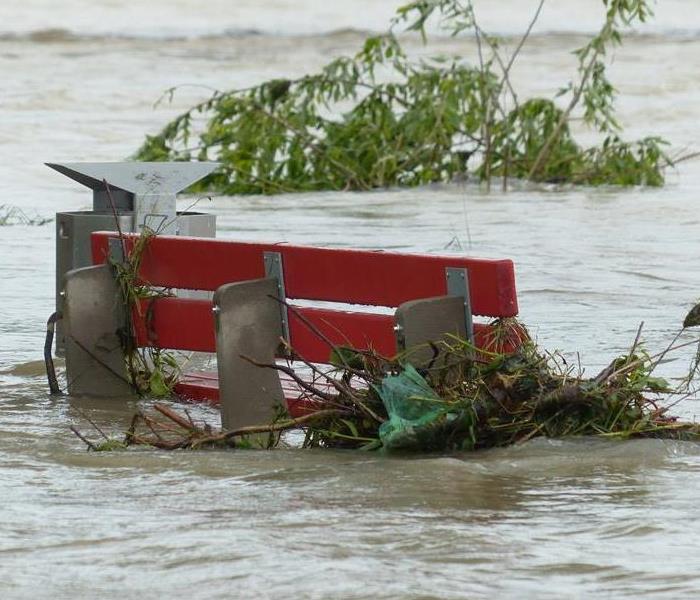 Dirty storm water pins debris against a park bench.
Dirty storm water pins debris against a park bench.
Almost a month after the remnants of Hurricane Ida hit NJ, many property owners are still dealing with the mess. We have been working 7 days a week to help as many people as possible. Our teams are bolstered by the support of multiple SERVPRO teams from out of state, and it is still not enough. Many homeowners have been tempted to handle the cleanup themselves but there are some serious considerations if you are going to do so.
First, make sure the area is safe. Downed wires and electrocution hazards need to be addressed before any work is done. If significant flooding has occurred, both the electrical service and gas should be shut off to prevent an explosion or electrocution. Sharp items such as broken glass must be removed to prevent puncture wounds and cuts which are highly prone to infection. Be aware of any displaced animals such as snakes. Always wear PPE such as rubber boots, gloves, and goggles.
Second, floodwater is contaminated. A river that has overflowed is carrying more than just the usual stream water. Flooding has washed contaminants downstream which may include:
- Human and livestock waste
- Household, medical, and industrial hazardous waste (chemical, biological, and radiological)
- Coal ash waste that can contain carcinogenic compounds such as arsenic, chromium, and mercury
- Other contaminants that can lead to illness
- Physical objects such as lumber, vehicles, and debris, or needles
- Wild or stray animals such as rodents and snakes
Third, exposure to contaminated floodwater can cause:
- Wound infections
- Skin rash
- Gastrointestinal illness
- Tetanus
If you experience any of these symptoms seek immediate medical attention.
For more information on the health concerns after a flood visit the CDC website at Floodwater After a Disaster or Emergency | CDC
Proper Water Remediation
9/30/2021 (Permalink)
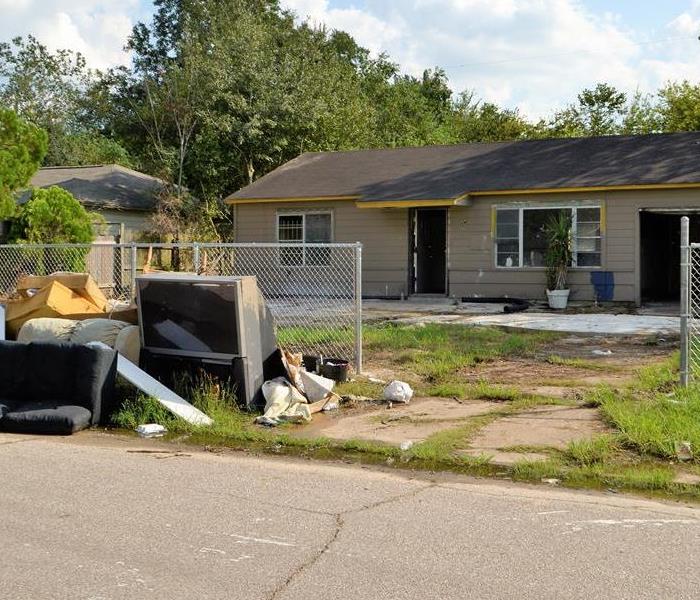 A home damaged by water during a storm
A home damaged by water during a storm
Even small water damages have the potential to cause serious structural and indoor air quality issues over time.
The key to avoiding costly future restoration is to handle every water problem as a real threat to your property. The proper equipment makes a huge difference in reducing the damage expense during a water loss. When time matters most, technology and equipment can be counted on.
Here are a few tools used by SERVPRO of Eatontown/Long Branch to properly mitigate a loss;
Moisture Sensors- used to detect moisture in carpets, baseboards and walls.
Moisture Meters- used to determine the actual moisture content of various materials. The meter provides accurate readings to monitor the drying process.
Thermo Hygrometers- measures temperature and relative humidity to calculate and create an environment most conducive to drying. When handling a contaminated loss (CAT 2 or 3), it is not only important to dry the structure, but disinfect and deodorize.
Ultra Low-Volume (ULV) Foggers- used to atomize liquid deodorizing agents, producing a fine mist that can easily penetrate the site where odor-causing residues may accumulate. It can also be used to inject fungicides and disinfectants into wall cavities and other hard-to-reach areas.
Thermal Foggers- dispenses solvent-based products by creating a dense fog that consists of tiny particles of deodorant solution that attach to and neutralize odor-causing particles.
The bottom line... ALWAYS treat water damage seriously. Call in a professional team like SERVPRO of Eatontown/Long Branch. We will work for you to restore your property and your life to make it "Like it never even happened."
Wet Memorial Day Weekend
5/28/2021 (Permalink)
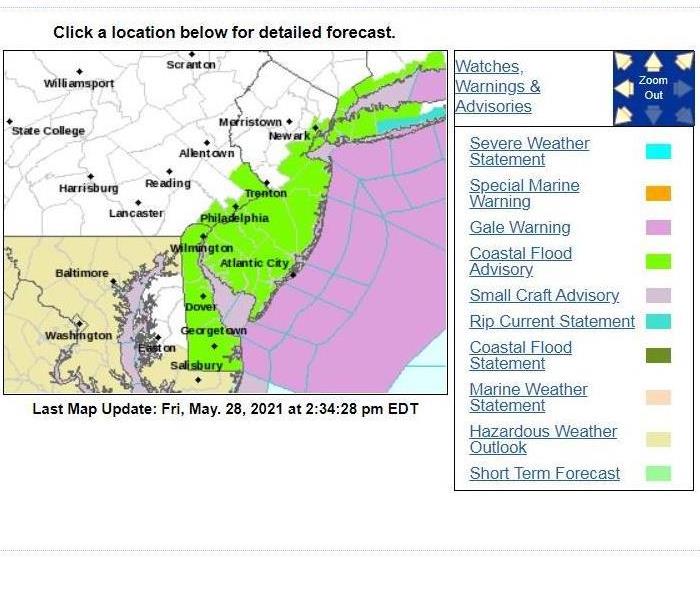 It is going to be a wet Memorial Day Weekend here in NJ!
It is going to be a wet Memorial Day Weekend here in NJ!
It is going to be a very wet Memorial Day Weekend. Hopefully, we will catch a break on Monday and be able to get out to honor our veterans. In the meantime, take a moment to prepare for significant rain and possible flooding. The National Weather Service is forecasting a couple of inches of rain across NJ with the potential for flooding along the coast, rivers, and low-lying areas.
As the first heavy rains of the season approaches, here are some quick tips to check and prevent water damage:
- Check your gutters and downspouts – if you have had any new landscaping or mulch installed check to make sure the water will flow freely away from the structure
- Check your basement sump pump to make sure it is operational
- Make sure items are on shelves or otherwise raised off of basement/ flood prone floors
- Make sure the patio furniture you just put out is secured
- Turn off the gas line to your grill
If you experience any water damage rest assured that SERVPRO will be ready to respond and provide assistance 24/7/365.
Have You Had Water Damage in Your Home?
1/28/2021 (Permalink)
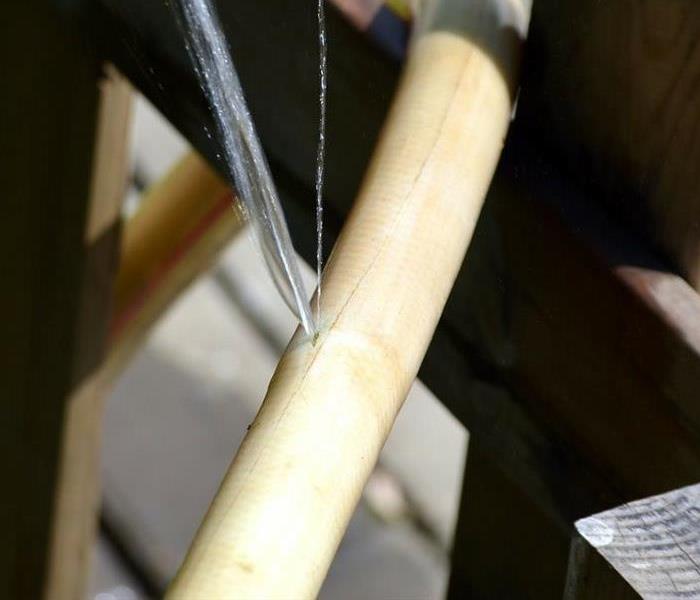 Water Spraying from a Hose
Water Spraying from a Hose
Have you had water damage in your home? On average, homes experience water damage once every 11 years. This damage is caused by a variety of sources, most of which can be mitigated through periodic monitoring and maintenance. Here are some tips to help you find some of the routine causes.
Gutters
- Make sure the gutters are not clogged by leaves and debris. This will cause standing water that can freeze and cause ice dams. For more information on ice dams click on this related blog Ice Dams
- Downspouts need to be extended far enough away from the house to prevent water from entering the basement
Plumbing
- Look for leaks under your refrigerator. Not only does removing dirt help improve the unit’s efficiency but the water supply line to the ice maker can come loose and cause a leak that is hidden due to its location. As a side note, I experienced a leak here about a year ago due to a mouse chewing on the supply line.
- Washing machines often have very old and degrading supply lines. Is yours appear worn you should consider a new set which are easy to install. Look for the ones that have a metal mesh around them for added reinforcement
- Dishwashers also have water supply lines and can have issues similar to ones noted in the refrigerator section.
Sinks
- As above, check the supply lines for leaks.
- Check the drain, especially the S-trap under the sink to make sure it hasn’t wiggled loose after being bumped by items stored in this space
Humidifiers
- One last time, check the supply lines. These units should be turned on in the fall and off in the spring at the closest valve to limit the risk of leaking during the warm weather.
If you experience water damage, call the experts at SERVPRO of Eatontown/Long Branch at 732-578-9888.
What Type of Water Is It?
1/27/2021 (Permalink)
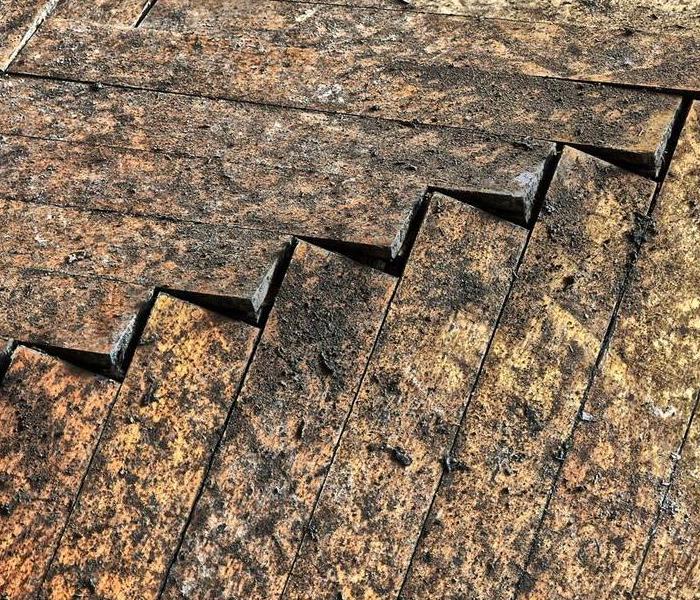 Boards after water damage
Boards after water damage
What type of water is it? No, sparkling or tap are not options when it comes to water damage. There are 3 classifications of water when it comes to flooding: Clear, Gray, or Black. These are not exact terms but designed to give an indication of the level of contamination within each.
Clear Water originates from water pipes such as water mains or plumbing in your home. It is always essential to remove the water as quickly as possible but clear water is the easiest because there are reduced safety procedures involved.
Gray Water is water which may have contamination. Therefore, a moderate degree of care and safety precautions are warranted. This water may come from storm damage or flood damage from more natural sources.
Black Water is the most serious and dangerous. SERVPRO technicians are trained in handling this material, along with many other biohazards. Typical sources may include septic tanks or waste water pipes that have ruptured. This type of water causes the most dangerous due to the microbial parts it contains and the accompanying health effects of exposure. Don’t tackle these situations yourself. Call the experts at SERVPRO!
You Will Thank Me One Day
1/20/2021 (Permalink)
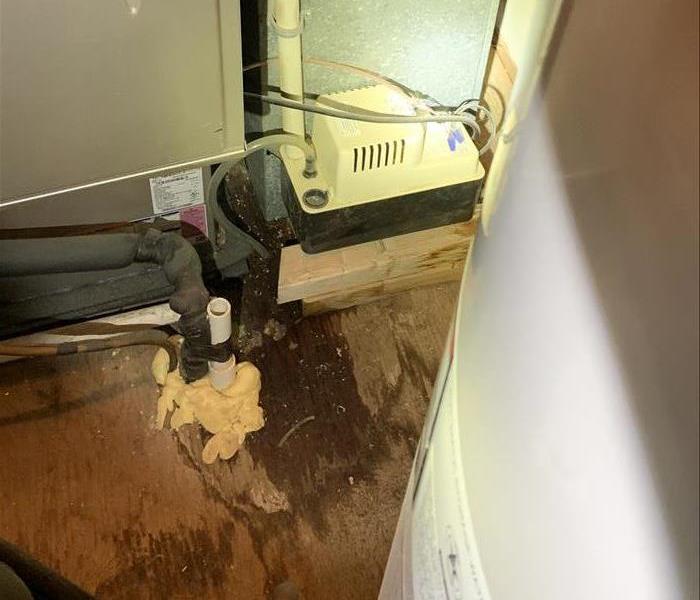 Water Collecting Next to a Furnace
Water Collecting Next to a Furnace
How often do you check the mechanical closet/spaces in your home? If you’re like me, you are proud of yourself if you remember to change the air filter even once a year. Like many issues that arise with home ownership, an ounce of prevention is worth a pound of cure.
I recently went into my mechanical closet to get a folding chair and noticed water on the floor. “Where did that come from,” I wondered. It wasn’t the hot water heater or near any plumbing. It was next to the furnace (see image). While the amount of water was fairly minimal, it would certainly result in a deterioration of the plywood flooring and create a breeding ground for mold.
I had my HVAC contractor come and the cause was a tiny hole in the exhaust flu. When the weather turned cold the moisture in the exhaust condensed and ran back down the flu, leaking out onto the floor. I paid $99 for the service call to have it repaired.
The lesson: check your mechanical areas periodically to look for signs of water, mold, or other mechanical issues that could result in more significant issues if not addressed. You will thank me one day…
It's Just Water
1/18/2021 (Permalink)
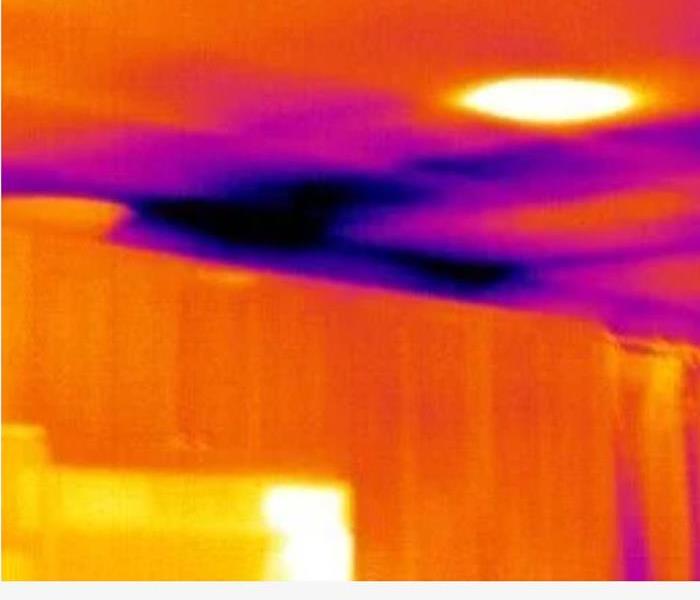 Water damage visible through a Thermal Imaging Camera
Water damage visible through a Thermal Imaging Camera
It’s just water, but it makes a huge mess! Even a small leak can create a massive amount of damage and pose serious health concerns for the long term. It is important that those cleaning up water damage have the proper training and equipment. This is not a job for your typical general contractor!
The cosmetic aspects of a remediation project are fairly obvious to identify but what about what you can’t see? Water saturated insulation, flooring, and sheetrock can be a breeding ground for potentially harmful mold that may not become apparent for a long time. This growth may also cause health issues including respiratory and auto-immune issues.
One way SERVPRO uses technology to assess the extent of water damage is with a Thermal Imaging Camera (TIC). This roughly $2,000 piece of equipment uses varying colors to show heat changes, making dampness visible. A local handyman or general contractor will not have this type of technology.
Wet areas in the building material do not warm and cool the same way adjacent dry areas do and this makes them visible when looking through a TIC. The photo shown here is from recent water damage at a local school here in NJ. To the naked eye the area shown appeared to be undamaged. However, when viewed as a thermal image the pattern of water soaking into the material from the flooded floor above becomes apparent. Had this area not been removed and replaced it could have created mold issue for the staff and students.
Don't Ruin Your Vacation
1/13/2021 (Permalink)
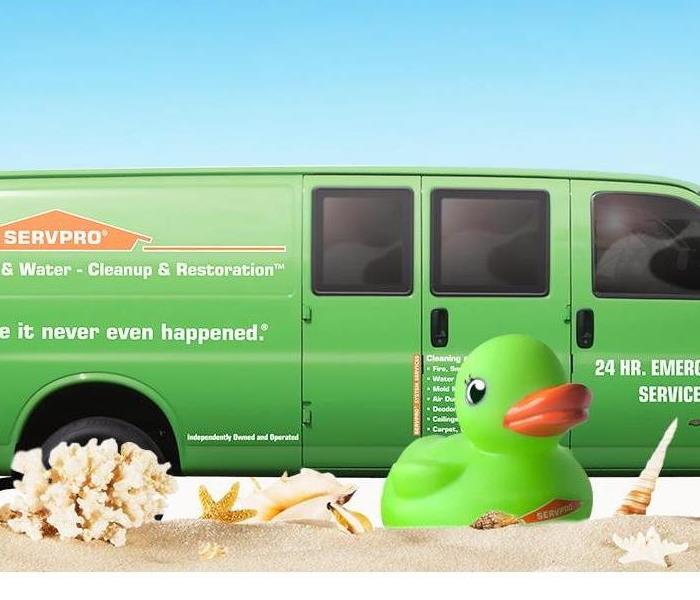 Oh, I'd like to be that van!
Oh, I'd like to be that van!
Are you looking forward to going on vacation again? Our family’s “Spring Break Trip” looks like it is going to be cancelled due to Covid, so my wife (Happy Birthday!) wants to take a road trip to FL. I love vacation but I always have that voice in the back of my head wondering if I set the alarm, locked the doors, and did my wife unplug the hair straightener (yes honey, I love you, and it’s your birthday, but this is a legitimate concern). But, what else am I forgetting? What about Water damage?
Before you leave, it is important safeguard your home from possible water damage. Here are some easy steps to protect your home and prevent vacation from being cut short due to a disaster.
Take a proactive look before you leave
Check for leaks in your plumbing, focusing on the pipes and connection you can see inside your house. The weakest points are places where hoses connect to taps or household appliances. Check under sinks for signs of leakage and rust and around water heaters, dishwashers, furnaces, and washing machines
Turn off the Water Supply
Shut off the water supply to the home and the hot water heater itself. Not only are hot water heaters a major culprit of water damage but there is no need to keep 75 gallons of water piping hot while you are away. Even a small leak, from a toilet supply line for example, can cause a massive amount of damage if not detected quickly (See our Facebook post from 12/4 at Simple toilet leak - NJ).You may also choose to, additionally, shut off the valves at your toilets, appliances, washers, and dishwashers.
Need Emergency Service?
9/2/2020 (Permalink)
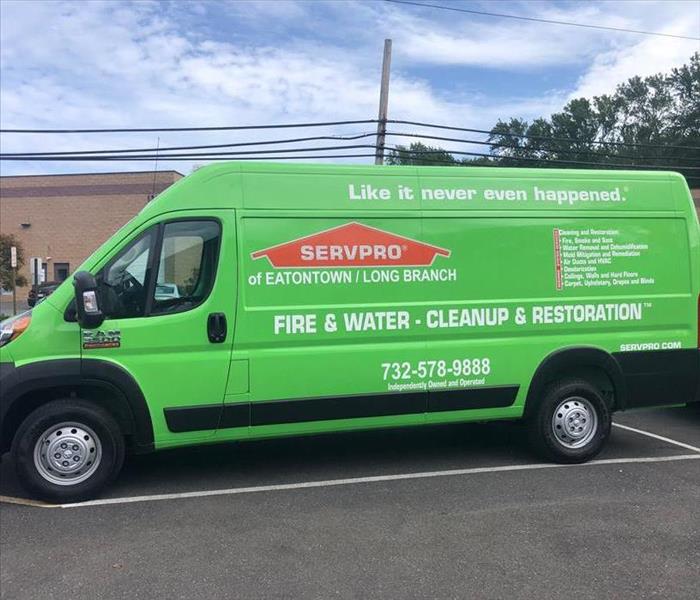 Available for you 24/7
Available for you 24/7
Need Emergency Service? Call Us 24/7 – SERVPRO of Eatontown/Long Branch - 732-578-9888
Water Damage Timeline
Within Minutes
- Water quickly spreads throughout your property, saturating everything in its path.
- Water is absorbed into walls, floors, upholstery, and belongings.
- Furniture finishes may bleed, causing permanent staining on carpets.
- Photographs, books, and other paper goods start to swell and warp.
Hours 1 - 24:
- Drywall begins to swell and break down.
- Metal surfaces begin to tarnish.
- Furniture begins to swell and crack.
- Dyes and inks from cloth and paper goods spread and stain.
- A musty odor appears.
48 Hours to 1 Week:
- Mold and mildew may grow and spread.
- Doors, windows, and studs swell and warp.
- Metal begins to rust and corrode.
- Furniture warps and shows signs of mold.
- Paint begins to blister.
- Wood flooring swells and warps.
- Serious biohazard contamination is possible.
More Than 1 Week:
- Restoration time and cost increase dramatically; replacing contaminated materials and structural rebuilding may be extensive.
- Structural safety, mold growth, and biohazard contaminants pose serious risks to occupants.
About SERVPRO of Eatontown/Long Branch
SERVPRO of Eatontown/Long Branch specializes in the cleanup and restoration of residential and commercial property after a fire, smoke or water damage event. Our staff is highly trained in property damage restoration. From initial and ongoing training at SERVPRO’s corporate training facility to regular IICRC-industry certification, rest assured our staff is equipped with the knowledge to restore your property.
We Specialize in Flooded Basement Cleanup and Restoration!
9/2/2020 (Permalink)
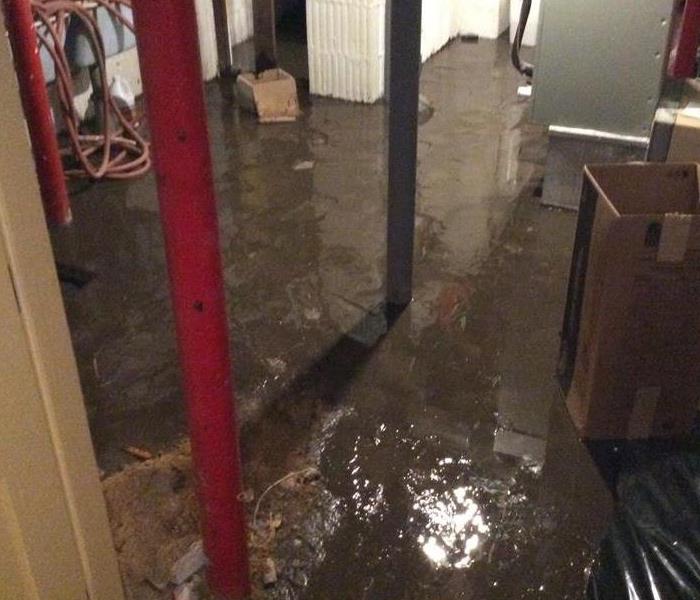 A broken pipe caused a flooded basement
A broken pipe caused a flooded basement
A basement can flood at any time, although flooding most often occurs during heavy rainfall. Basements are inherently prone to flooding because they are the lowest level of a building and are normally built partly or entirely below ground level. There are a number of reasons why your basement could flood, including:
- A blocked or failed sewer lateral pipe
- Heavy rain causes surface water to pool around your home
- Storm sewer backup
- Sanitary sewer backup
- Foundation drainage failure
- Water supply-line break or hot-water tank failure
- And many more
Have Questions about Basement Flooding?
Call Today - SERVPRO of Eatontown/Long Branch - 732-578-9888
If flood water is not handled quickly and properly, it can jeopardize your health and safety, and cause severe damage to your home’s structure. Remember, the longer you wait, the worse the problem will get.
The bottom line: a flooded basement can jeopardize your health, safety, and your home’s integrity. It’s worth making a call to SERVPRO of Eatontown/Long Branch and let our trained, professional crews handle the situation safely and correctly. We have earned the trust of hundreds of homeowners, business owners, and property professionals.
We are Flooded Basement Specialists:
- We are Available 24 hours/7 days per week
- We’re a Preferred Vendor to many National Insurance Companies
- We Bill The Insurance Directly – One Less Thing For You To Worry About
- Our Technicians are Highly-Trained in Water Restoration Techniques
- We use s500 IICRC Restoration Standards
- Advanced Inspection and Extraction Equipment
Basement Flooded? Call Us Today – We’re Ready To Help - SERVPRO of Eatontown/Long Branch 732-578-9888
Water Damage
5/20/2020 (Permalink)
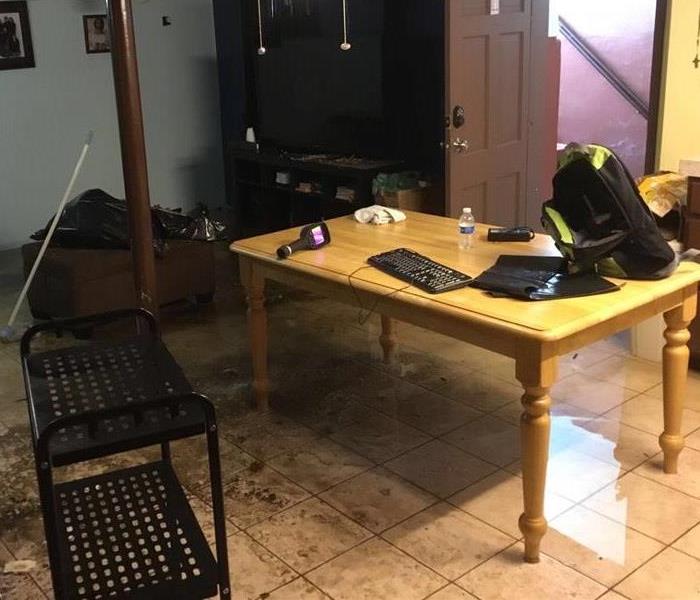 Water damage in residential home.
Water damage in residential home.
SERVPRO of Eatontown/Long Branch is available 24 hours a day for water emergencies, large or small. When you are dealing with water damage, immediate action is crucial. A delay of just a few hours can greatly increase the severity of the water damage.
We Answer the Phone Ready to Help
Call Today - 732-578-9888
We understand that when you call us, you may be feeling confused, stressed, and vulnerable. You need an expert to guide you through this crisis. SERVPRO of Eatontown/Long Branch has the specific water damage training and experience to help you through this tough time. We specialize in water damage restoration—in fact, it's the cornerstone of our business.
What to Expect
When you call, we will ask several questions regarding your water damage emergency. These questions will help us determine what equipment and resources to bring, including how many trained SERVPRO Professionals may be needed.
Our SERVPRO Representative will ask several questions:
· Your name and contact information
· Your insurance information (if applicable)
· The street address of the water-damaged home or business
· When did the flooding or water damage occur?
· What caused the water damage (if known)?
· Is there electricity available (on-site)?
About SERVPRO of Eatontown/Long Branch
SERVPRO of [Eatontown/Long Branch specializes in the cleanup and restoration of residential and commercial property after a fire, smoke or water damage event. Our staff is highly trained in property damage restoration. From initial and ongoing training at SERVPRO’s corporate training facility to regular IICRC-industry certification, rest assured our staff is equipped with the knowledge to restore your property.
A Water Damage Timeline
3/26/2020 (Permalink)
Living on the Jersey Shore, it's inevitable that there will be some sort of water event (groundwater, nor'easter, etc.) at some point during the year. Depending on your actual location, and how much water is flowing and how fast and/or how forcefully, water damage can begin occurring almost immediately.
Unfortunately, the longer water sits, the more time it has to cause even further damage. Stagnant water can become a breeding ground for mold, bacteria, insects, or other contaminants.
This is why it’s important to dry everything as quickly as possible in order to minimize the long-term damage.
In Minutes…
- Water can soak into paper and cardboard, ruining them beyond repair
- Water can cause stains and other noticeable surface level damage to furniture, carpeting, ceilings, and walls
- Water can cause electricity-powered devices to short out
In Hours….
- Walls and furniture made of composite materials can start to dissolve
- Carpet padding can start to fall apart, and carpet backing can become weakened
- Items made of unfinished wood can start to swell
- Upholstery and fabrics can develop stains
- Musty odors can start to develop
In Days….
- Structural beams can start to swell and warp
- Carpets and fabrics can start to dissolve
- Mold can start growing
In Weeks…
- Wood floors and furniture can start to swell, warp, and dissolve
- Mold can grow to the extent that it poses a severe health risk
- The structural support of your home can become so weakened that it is now unsafe
Taking care of the problem early will eliminate the need for very costly remediation later. Make sure you make the call to the professionals at SERVPRO of Eatontown/Long Branch as soon and as quickly as possible. Most water damage is covered by insurance, and we will work directly with your insurance company to make the process less stressful, simple and seamless.
Water Damage Isn't Always From a Storm
12/11/2019 (Permalink)
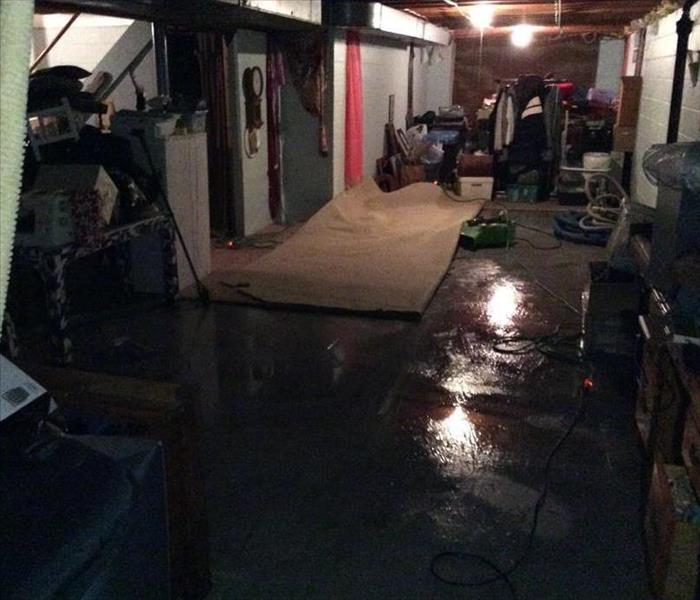 A broken water heater caused the water damage in this basement, affecting the entire floor and contents.
A broken water heater caused the water damage in this basement, affecting the entire floor and contents.
When people think about water damage, often, especially in our area close to the Jersey Shore, they think of major storms like Hurricane Sandy or coastal flooding. In reality, most water damage is “man made.”
The majority of water damage in homes stems from leaking or broken pipes, pipe fittings or caps, burst or leaking water heaters, appliances, kitchen and bath fixtures and sump pumps.
For pipes, these simple steps can deter major issues once winter weather settles and it becomes cold.
OUTDOORS:
- Wrap outside faucets.
- Caulk around pipes where they enter the house.
- Disconnect garden hoses.
- Drain in-ground sprinkler systems.
INDOORS:
- Check your home for places where water supply lines are not heated (e.g., in a basement or garage).
- Let a stream of water run if the temperatures dip below freezing.
- Open cupboard and vanity doors in the kitchen or bathroom.
- Keep the thermostat set to the same temperature both during the day and at night. By temporarily suspending the use of lower nighttime temperatures, you may incur a higher heating bill, but you can prevent a much more costly repair job if pipes freeze and burst.
- Shut off and drain your water system if you are leaving the home for several days or more, and set your thermostat a temperature no lower than 55° F.
Water heaters, on average, should last anywhere between 8 to 12 years. A broken water heater can leave over 50+ gallons of water all over your house, depending on how big it is.
How can you tell if it’s time to change your water heater? There are definitely signs.
- If your water heater is getting up in years, it may be time to replace it before it breaks.
- Tinted water coming from your hot water tap means there may be rust in your water heater, which is a possible indicator your hot water heater is showing signs of wear and may start to leak.
- Gurgling or popping noises coming from your water heater are caused by the buildup of hard water sediment heating up and exploding inside your water heater tank.
- Look around the base of your hot water heater for dampness. This may be a symptom of a slow or intermittent leak.
- If you have no hot water while using your hot water tap, it may be a sign that your water heater needs to be checked out.
- If you see a puddle around the base of your hot water heater, immediate action should be taken to replace it.
To save yourself and your home from a sewage backup, here’s some advice to keep in mind.
- Keep your drains clear of clogging. Don’t flush items down your toilet that can cause build up in the pipes, such as diapers, sanitary napkins, or thick waste. Also, don’t get rid of grease down the sink, as grease can harden within the pipes and then collect other waste, creating a major clog.
- Conduct regular inspections of all the pipes and valves in your home and make sure they are well maintained.
- Don’t plant trees too close to the sewer lines, as over time the roots can grow and damage the pipes.
Keep a working sump-pump on hand, just in case.
And speaking of sump pumps….. a sump pump is designed to help you prevent water damage, but if the sump pump itself fails, you’re in trouble. In order to keep your sump pump in good running order, it’s smart to service it at least once or twice a year. You can do this yourself by pouring a bucket of water into the sump pump basin to make sure it’s working properly. You may want to consider replacing your sump pump about every 7 years depending on use.
Even with all this preparation, accidents can still happen. In that case, calling SERVPRO of Eatontown/Long Branch immediately will ensure that any water damage will be cleaned by professional technicians and your home will be restored “Like it never even happened.”
How Often Do You Think About Your Plumbing?
12/7/2019 (Permalink)
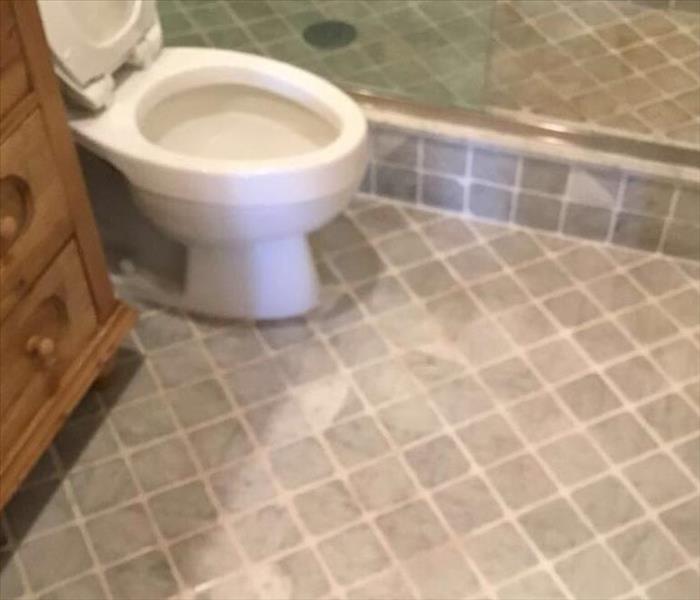 Toilets are often a cause of water damage, either by overflowing (sewage) or leaking. Damage can be extensive.
Toilets are often a cause of water damage, either by overflowing (sewage) or leaking. Damage can be extensive.
Many homeowners overlook issues that could develop into significant plumbing problems, and maybe even expensive water damage.
An easy visual inspection or simple test is often all it takes to ensure your plumbing is in good working condition and catch any problem before it becomes as major catastrophe.
Here’s a checklist of 4 common plumbing problems, and what you can do to prevent them from becoming a problem for you:
Washing Machine
Did you know that the average washing machine will use up to 40 gallons of water each cycle? With that much water pumping through, you want to be sure to check both the supply and wastewater lines about once a quarter.
Sinks
One of the biggest wear-and-tear problems for sinks are the seals and washers which will deteriorate over time.
You’ll want to check under the sink cabinets for any signs of leaking, which could include dampness, deterioration, or odors.
Toilet
When your toilet starts to wear down, it could lead to higher monthly water bills, or even potential flooding and major water damage.
In order to inspect your toilet, remove the tank lid and flush and make sure all the components (like the flush valve and flapper) are all in good working condition.
One easy way to check for a toilet leak is to add a couple drops of food coloring into the tank. After a few hours, check the bowl – if you see the dye color, then you know there’s a leak problem.
Showers & Tubs
Showers and tubs are often the most heavily used plumbing fixtures in a home, so it’s important to make sure everything is working properly.
Make sure to check faucets, drains, and shower heads on a regular basis. You’ll also want to check the seals. If caulk deteriorates, it could lead to a mold problem behind your walls.
If you see any signs of damage or corrosion, or if you decide you’d like a professional opinion, our team of experts here at SERVPRO Eatontown/Long Branch can help make sure you minimize any water damage. And if you do need more advanced help, know that we have all the specialized training and equipment necessary to handle even a large-scale water emergency.
5 Common Causes of Water Damage in Homes and Businesses
10/30/2019 (Permalink)
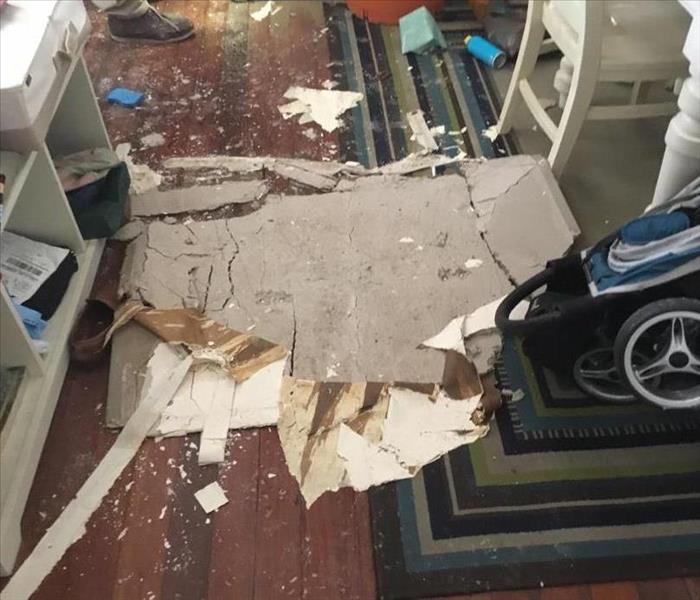 Water damaged the ceiling of this home, and ended up with the ceiling collapsing onto the living room floor
Water damaged the ceiling of this home, and ended up with the ceiling collapsing onto the living room floor
Do you have a water problem? Water is plentiful in nature and essential to life, but too much water in all the wrong places can be disastrous to homes and businesses. Water can breakdown drywall, hardwood, and other structural elements of a building as well as lead to hazardous mold conditions
Here at SERVPRO of Eatontown / Long Branch, we know how important it is to diagnose and fix a water problem quickly, before it turns into a catastrophe. Although sometimes the cause of water damage is obvious and unavoidable – major flooding from a hurricane, for example – there are actually several common causes of water damage that start small but can turn big and hazardous, especially if they go unnoticed.
In order to help you prevent water damage, here are 5 common causes of water damage you should pay attention to:
Backed Up Sewage
When sewage backs up, there is potential danger both from water damage and waste that can carry bacteria, parasites, and other contaminants.
Open floor drains are typically the most common cause of backed up sewers, but they can happen even with a closed waste system.
Leaks in Your Roof
It is common for roof shingles and decking to wear out over time, and as your roof weakens, there is an increased chance that rain or snow will lead to water damage.
Unfortunately, it is common for a roof problem to go undetected until it is too late. That’s why it’s a good idea to make a visual inspection of your roof at least twice a year. Also, pay attention to your ceilings for any signs of water stains, soft spots, or mold.
Problems with Your Foundation
Damaged foundations are also a common cause of water damage. Cracks, gaps, and general wear and tear to your foundation can make it possible for water to start to seep into your basement or crawl space, sometimes so slowly that it can go unnoticed until there’s a problem.
It’s a good idea to check your foundation regularly, and especially after storms or rapid snow melt when any small problem might quickly intensify.
Leaks in Your Plumbing
The valves and fixtures of your plumbing system will wear down over time and may cause at first just tiny leaks that easily go unnoticed, especially if the leaks are behind walls or otherwise hidden from plain sight.
To help prevent leaks, make sure to check your valves at least twice a year and replace them every 20 years or sooner depending on their condition. If the valves are behind walls, be on the lookout for signs of water spots or sagging drywall.
A Malfunctioning Sump Pump
A sump pump is designed to help you prevent water damage, but if the sump pump itself fails, you’re in trouble.
In order to keep your sump pump in good running order, it’s smart to service it at least once or twice a year. You can do this yourself by pouring a bucket of water into the sump pump basin to make sure it’s working properly. You may want to consider replacing your sump pump about every 7 years depending on use.
Here at SERVPRO of Eatontown / Long Branch, our mission is to be “faster to any disaster.” So, if your home or business is in need of help for water damage, our team of advanced technicians will be on hand bringing the advanced equipment and specialized training needed to clean and restore your damaged property as quickly as possible.
Why SERVPRO Can Help with Water Damage – Even When It’s Not Obvious What / Where the Problem Is
9/13/2019 (Permalink)
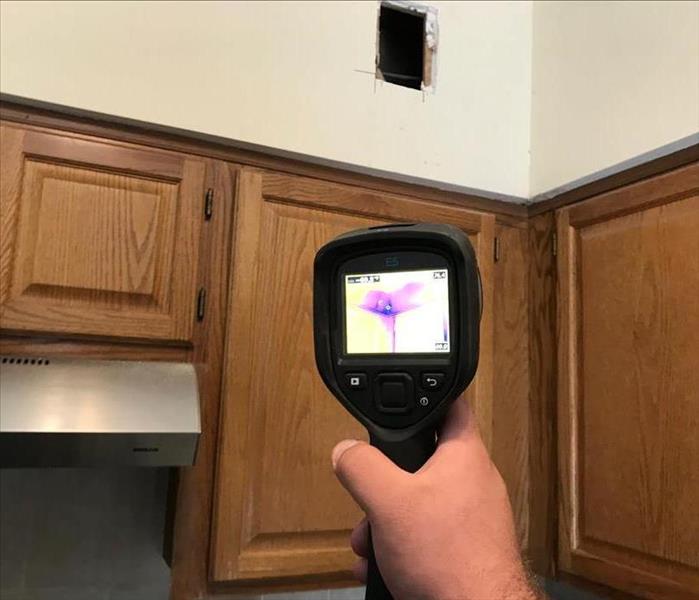 SERVPRO has special equipment to help see moisture even when its not outwardly visible
SERVPRO has special equipment to help see moisture even when its not outwardly visible
Sometimes water damage and its source are easy to identify – for example when a pipe bursts or a major storm causes flooding. But sometimes the problem can be more subtle…and that can actually lead to more damage over the long-term if you don’t recognize a problem before it becomes a potential disaster.
If you’re concerned there may be a water problem in your home or business, here are 5 common but not-so-obvious signs to look out for:
Water Stains
If you see pale yellow or brown stains on your ceilings, wall, or floors, that may indicate the presence of a slow but steady leak.
Many times, water stains will form directly under the water source. However, sometimes water will run along wire, pipes or other materials and then drip and cause stains far from the source. Make sure you figure out the cause of the water damage you see.
Mold Growth
Mold grows where there is sufficient wetness for it to thrive, so if you have a mold problem, there’s a water problem.
Sometimes materials in your home will become mold infested if they’ve become wet and have never been able to dry sufficiently. This can happen to fabric, wood, insulation, and perhaps even your floors, ceilings, or walls.
Odors
A musty smell can be one of the first signs of a water problem, even if you can’t yet see any leaks.
Be on the lookout for any sudden changes in odor. Take note if it gets worse after a rainstorm or while you’re taking a shower or running the dishwasher.
Weak Wall, Floors, or Ceilings
Water will weaken your building materials. You might notice that your walls are becoming more soft or “spongey”, your floors might be bowing, there may be a crack in your ceiling or a bubble in your wall paper.
A sudden large leak might cause a major, obvious problem, but if the leak is slow these issues might come on gradually over weeks or months. The sooner you notice, the sooner you can address the root cause.
Higher Utility Bills
If you have a sudden and unexpected surge in your utility bill, that might be an indication of a water problem.
While slight fluctuations month to month are normal, be on the lookout for a sudden rise in the water bill, especially if there’s no corresponding increase in your sewer rates. If there isn’t a reason you can think of why your water bill might be high this month, it may be that there’s a water damage issue.
Here at SERVPRO of Eatontown / Long Branch we know just how disastrous water damage can be to a home or business. That’s why we’re passionate about helping the people in this community do what they can to prevent water damage before it becomes a major issue.
But IF you have water damage – even just minor damage – SERVPRO of Eatontown / Long Branch can help you identify and address the source of the problem and ensure that it won’t turn into an expensive catastrophe for your home or business.
Is Your Water Bill is Too High?
9/2/2019 (Permalink)
It can be normal for your water bill to fluctuate from month to month - you may be watering your lawn more in the Spring or Summer, or doing extra laundry if you have guests visiting. As long as you know why your water bill is higher, there shouldn't be any cause for alarm. However, sometimes you may notice an unexpected large increase…and that could be a sign of water damage
To help you prevent severe water damage to your property, here are 4 common kinds of leaks to look out for that may be causing your water bill to be too high:
Leaking Faucets
A leaky faucet may just release a few drops of water, but if you wind up with a severe leak you could be wasting as much as 20 gallons of water every day. That’s why it’s important to check each faucet to make sure there are no visible signs of a leak.
One way to check is by placing an empty cup underneath the faucet and making sure no water collects. You’ll also want to take a look at the piping in the cabinets underneath the sink, and don’t forget to check your outside hoses and water sources as well!
Leaking Pipes
Plumbing leaks can sometimes be difficult to detect as many of your pipes may be hidden behind walls or above the ceiling. Still, you can at least make sure to check all the visible fittings and fixtures for any signs of damage or leaking.
As for your hidden pipes, you can pay attention to the ceiling and walls themselves. If you notice any signs of discoloration, deterioration, or mold, that can be a clue to the source of the problem.
Leaking Toilets
A continuously running toilet can waste as much as 200 gallons of water every day and cause your water bill to soar.
One easy way to check if you have a leak is to dispense a few drops of food dye into the tank of your toilet. If you see the color start to come into the bowl, that’s a sign of a potentially bad leak.
Purification Systems / Water Softeners
If you use a water softener or purification system, that could be the cause of your bill increase. These systems tend to produce more waste water than other plumbing systems.
If you water bill is suddenly high, you want to make sure that these systems are working correctly and not producing excessive water waste.
Here at SERVPRO of Eatontown / Long Branch, we are available 24/7 and can be at your home quickly to help you if you do have water damage. Our local team is made up of the best advanced technicians with the training and equipment needed to handle any size disaster.
Your Step-by-Step Guide to Drying Carpeting after Flooding and/or Water Damage
5/17/2019 (Permalink)
If your home or business has been damaged by flooding or a water leak, your carpeting may be a soggy, water-logged mess. When this happens, it’s imperative to dry the carpeting quickly in order to prevent damage to your walls, sub-flooring, and other structural elements of your building. The good news is: the drying process is one you can often start on your own almost immediately after the incident!
Here at SERVPRO of Eatontown / Long Branch, we know how devastating water damage can be to a home or business. As a leader in professional restoration services we want to help make sure you mitigate any damage that may occur to your property due to a water problem.
Here’s how to start drying your wet carpeting in order to prevent further damage:
Identify and Stop the Source of the Water Problem
The first step in saving your carpeting is to identify the source of your water problem and do your best to stop it, or at least to lessen it.
Remove Any Standing and/or Excess Water
Once there’s no more water coming in, your next step is to start to remove any standing or excess water.
The sooner you can start drying out your carpeting, the better your chances of salvaging it. If there’s standing water completely covering the carpet, you may want to rent a pump from your local hardware store to start extracting it.
Another useful tool is a wet/dry shop vac which can be used to suck up excess water from a saturated carpet.
Separate the Soaked Carpeting from the Floor
Once you’ve removed most of the water, now you will want to separate the carpet off from the floor.
Once you’ve pulled up the carpeting, you’ll want to dispose of the carpet padding. (Carpet padding is typically inexpensive and generally easier to just replace than to try to dry out).
Dry, Dry, Dry!
Once the carpeting is separated from the flooring, it’s time to do your best to dry both completely.
It’s often useful to move the carpeting to another totally dry area. Use high-powered fans and/or blowers on both the flooring and the carpeting. SERVPRO has professional grade equipment that will do the job better than any home/retail equipment can do.
Replace and Clean the Carpeting
Once the floor has been cleaned and you’ve installed new carpet padding, it’s time to re-install and clean your carpeting. In most cases, however, replacing the carpet is the norm.
Bring In Professional Restoration Services
In cases of significant water damage, specialized equipment and training is often needed to thoroughly fix the problem and restore your property to like-new conditions.
Here at SERVPRO of Eatontown / Long Branch, we’re proud to be helping homes and business deal with water damage that’s gone beyond their control. We have all the necessary training and equipment to quickly and efficiently dry your wet carpeting, limiting your risk of mold/bacteria exposure and increasing the chances of saving your carpeting.
How to Prevent Water Damage: Everyday Tips and DIY Tricks
3/29/2019 (Permalink)
Water damage can be unpredictable. However, there are steps you can take to help prevent it. In fact, it can be quite easy to make sure your plumbing and HVAC systems are in good working order.
Here at SERVPRO of Eatontown / Long Branch, we’re proud to be leaders in cleaning and restoration services here in this community. Our team of advanced technicians has all the specialized knowledge, training, and equipment necessary to handle any size disaster. But rather than cleanup after a disaster, we’d like to help you prevent major damage from occurring in the first place.
Here are some ways you can prevent water damage on a day-today basis, both when you’re at home and traveling away for an extended period:
Everyday Water Damage Prevention Tips
If you’re careful about what goes down your drains, you can help prevent cracks and damage to your pipes that might otherwise lead to leaks and water problems.
- Be careful what goes down your toilet. It’s a good idea to flush only human waste and toilet paper. Note: even “flushable” wipes can clog toilet drains, especially in bulk.
- Make sure not to pour grease or coffee grounds down drains as these can clog pipes and sewer lines.
- If you have a drain clog, try using a drain snake rather than a chemical cleaner as a snake is typically both more effective and less potentially hazardous.
DIY Water Damage Preventative Maintenance
Here are some easy DIY steps you can take to inspect and maintain your water supply. If you do notice signs of wear and tear or incorrect operations, be sure to call professional services soon before a small problem turns into a major home disaster.
- Clean your gutters regularly once a year and be sure to check them after heavy storms to make sure water is flowing properly.
- Once a year, make sure to visually inspect your plumbing - including any toilets, sinks, tubs, washing machines, or dishwashers – and look for any signs of damage or leaking.
- Flush your sinks with baking soda and vinegar to help prevent clogs. You can use lemon juice to eliminate any odors.
- Consider investing in a sump pump in case of flooding and be sure to check it regularly to make sure it is in good working order.
Pay attention to your water bill each month. An unexpected increase may indicate that water is leaking somewhere.
Water Damage Prevention When Traveling
If you’ll be traveling away on vacation, here are steps you can take before you leave to help prevent any water problems while you’re away.
- Adjust your HVAC settings to a low setting or turn them off completely if possible.
- Consider turning off your water supply and draining your pipes.
- Ask a neighbor to check on your house every few days to make sure there aren’t any developing problems.
While it’s not always possible to prevent water damage, these tips can help minimize your chances of having to deal with a major water-related emergency. And if something should happen, know that SERVPRO of Eatontown / Long Branch is available 24/7 to help deal with any size water damage problem, large or small.
How to Deal with Water Damage to Your Home
2/12/2019 (Permalink)
If you’re facing water damage, there are some steps you can take to minimize the costs of restoring your home. The following are tips that can help you lessen the effects of any future water damage.
Just remember that depending on the extent of the damage, sometimes your smartest move is to call a professional right away. Your first priority needs to be making sure you and your family are safe.
Safety First
Before you can clean and restore your home, you first have to get rid of the mess.
Molds and bacteria flourish and grow in any damp space with little air flow, and can be very dangerous. Anyone working on cleaning-up water damage ought to wear protective clothing such as masks, gloves, and safe footwear.
Electrical hazards and the potential to slip and fall are the other major safety concerns – only perform those clean-up activities you know to be safe.
When belongings get wet, they can become much heavier than normal; you don’t want to attempt to lift something that is too heavy and hurt your back on top of everything else!
Remove Damaged Items
If your basement has flooded, you need to get the damaged items out. Unfortunately, many things may be beyond saving, or easier and cheaper to just replace rather than try to salvage. If you can make some of these decisions earlier rather than later, it may help you save costs in the long run.
Remove Water and Let Your Home Dry
Sometimes, the amount of water will be too much to remove yourself and you should call your cleaning and restoration professionals right away. Prop-up wet cushions and upholstery somewhere they can dry out. And place a piece of aluminum foil or wood blocks between furniture legs and wet carpeting to prevent further water damage.
Ripping up soaked carpet will most likely be necessary - be careful of nails and carpet tacks.
DO NOT use any electrical appliances that may have gotten wet or damaged themselves. A household vacuum cleaner is generally not a good option for cleaning-up after water damage, however, if you can get your hands on a commercial grade shop vacuum, that may help you clean and save some money in the process.
Disinfect
Once you’ve removed the water and damaged items, you’ll want to use a disinfectant to clean up the remaining affected areas. There are some green products that are safe to use and can help make a difference to the amount of professional grade cleaners you may ultimately need. Just be sure to read the labels and wear your protective gear.
Get the Air Circulating
The extent of bacteria and mold growth will depend on a number of factors, including moisture level, temperature, and the presence of wood and paper materials on which they can feed. If significant mold growth develops, that will increase your remediation costs – so it’s important to start drying as much as you can as soon as you can.
While your household fans can’t compete with professional equipment, they certainly can help and ultimately reduce remediation costs. Running a dehumidifier can also help remove excess humidity from the affected environment.
If you do require professional water damage restoration services, the professionals at SERVPRO of Eatontown / Long Branch offer 24-hour emergency service. We’re a locally owned and operated company here in your community providing the highest caliber water inspection, extraction, drying, and restoration equipment and service.
Is Your Hot Water Heater Leaking? Here’s What to Do.
11/5/2018 (Permalink)
Finding out that your hot water heater is leaking is never a pleasant experience. But this minor emergency doesn’t have to become a major disaster.
Here’s a list of steps you can take to minimize the damage from a leaking heater:
Confirm that it is, in fact, your water heater that’s leaking.
Sometimes looks can be deceiving. If you see a puddle of water under your hot water heater, it’s obvious why your first thought would be a heater leak. But that may, in fact, not be the problem.
If it’s a small puddle, your first step should be to clean-up the water an inspect the heater. Do you see any wet fittings or other signs of leakage from the tank itself? Check your surroundings for other water sources? Maybe there’s a nearby window or pipe that is the actual source of the water you see. Don’t forget about the effect of gravity! If your floor slopes, the water may have traveled from a different source point to the place where it ultimately pooled.
Turn off the water.
If you do have a leaking water heater, the next recommended step is to turn off the water.
Your hot water heater should have its own shut off valve.
If your valve is broken, you may need to shut off the water to your home. If you need assistance, reach out to your local expert professionals.
Cut the power.
Whether you have a gas or electrically powered water heater, your next step is to shut off the fuel source that powers your heater.
A gas tank should have its own dedicated shut-off gas valve. You want to make sure the gas is off so your heater will be safe to work with. If you have an electric tank, you can shut off the power at the breaker.
Try to determine the location and cause of the leak.
Now that the water and power are off, you will be in a better position to assess your situation and try to determine the location and course of your leak:
Check the pipes that connect to your heater for any loose fittings. This may just require quick tightening with a wrench.
- Check your pressure relief valve. If the temperature or pressure is too high, this could be causing valve leaks. Your water heater should be around 120 degrees Fahrenheit and the pressure shouldn’t be over 80 PSI.
- Check the drain valve to make sure it doesn’t need replacing.
- Check the bottom of the water heater itself -- it may be that the tank itself is cracked and needs to be replaced.
If you determine that it is your tank that is leaking and the leak is serious, you may want to drain the tank to minimize further water damage.
Hopefully, the leak from your hot water heater hasn’t caused too much water damage. But if you need professional assistance, the restoration pros at SERVPRO Eatontown / Long Branch are here to help. We’re equipped to handle any size water damage restoration needed for either residential or commercial buildings.
Just call us any time 24/7 at 732-858-5422
A Simple Step-By-Step Guide for Dealing with Water Damage
9/17/2018 (Permalink)
It’s a homeowner’s nightmare: water damage. An extensive water problem in your home can feel overwhelming. Unfortunately, serious problems – like mold growth – can begin within 24 hours, so it’s important to assess your situation and act quickly.
If you’re staring at a pool of water in your home and wondering what to do next, here’s a guide to help you start getting everything back to normal.
Call for Professional Water Damage Restoration Services ASAP
The simple fact is, the quicker you bring in professional help, the better your chances of minimizing the long-term damages and costs.
Check Your Insurance Coverage
Once help is on the way, check your homeowner’s insurance to see if your water damage will be covered.
Typically, a sudden major flooding event (like bursting pipes) is more likely to be covered than a long slow leak. You’ll want to act fast in order to make a claim. It’s also a good idea to take photos to document the evidence.
SERVPRO of Eatontown/Long Branch can help you manage the insurance paperwork process – just ask!
Remove Any Items You Can
When you’re dealing with water damage, remember: safety first.
“Slip and fall” accidents and electrical hazards can be common in water damage situations, so only perform those clean-up activities you know to be safe.
If it is safe to do so, remove any items you can from the affected area. It’s a good idea to gather any loose items from the floor, especially colored rugs, or other colored materials that might leave a stain. Prioritize the removal of any valuables as well as any wet items like cushions or upholstery that can be taken out to dry.
Remember: water-logged materials can be very heavy, so make sure to be safe and handle them carefully!
Dry Out the Damaged Area
If it is safe, start drying out the wet area.
Mops and buckets can be useful to remove excess water quickly. Also wipe down any wood or porous objects that may be more sensitive to water damage. Open windows and doors to allow maximum air circulation.
Also, if you have access to electricity, run an air conditioner and/or fans on high and use a dehumidifier. While a wet-dry vac can be a useful tool to deal with minor flooding, NEVER use a vacuum cleaner to remove excess water.
Remember: if there are any electrical hazard concerns, do NOT attempt to use any appliances.
Disinfect Damaged Surfaces
Once you’ve removed excess water, you can start to disinfect the damaged area to clean-up and prevent further mold growth and other contamination.
A simple cleaning solution is one-part household bleach to one-part water. Just lightly spray and wipe down any affected non-porous surfaces.
SERVPRO of Eatontown/Long Branch is a locally owned and operated organization of highly trained technicians with the expertise and advanced technological equipment needed to clean-up and repair your water damage fast. We’re ready to respond to your emergency situation immediately, and we will oversee and document the entire process until your home is fully restored.
What to Do When Sewage Backs Up in Your Home
9/4/2018 (Permalink)
A sewage backup can be a homeowner’s nightmare.
Having to deal with a disgusting mess and the damage to items in your home are often just the start of the problems. If the backup is severe enough, you may have to keep out of your house until the damage restoration is complete. There are also potential serious health risks from the contamination. And don’t forget about the potential major hit to your wallet, especially if you have to pay not only for restoration services but for replacements of ruined furniture and appliances too.
In order to protect your home, it’s good to know some preventive measures you can take, as well as the best steps to follow right after a sewage backup to mitigate the damage.
Prevention
To save yourself and your home from a sewage backup, here’s some advice to keep in mind:
- Keep your drains clear of clogging. Don’t flush items down your toilet that can cause build up in the pipes, such as diapers, sanitary napkins, or thick waste. Also, don’t get rid of grease down the sink, as grease can harden within the pipes and then collect other waste, creating a major clog.
- Conduct regular inspections of all the pipes and valves in your home and make sure they are well maintained.
- Don’t plant trees too close to the sewer lines, as over time the roots can grow and damage the pipes.
- Keep a working sump-pump on hand, just in case.
Aftermath
If a sewage backup does happen, you may be able to limit the damage considerably if you take the following steps:
- Call for professional sewage cleanup and restoration services ASAP. Special training and equipment is necessary to safely deal with the hazards of unsanitary sewage water, and the quicker you enlist help, the better you can contain this emergency situation.
- Put on protective clothing, such as gloves, rubber boots, and protection for your eyes, nose, and mouth.
- Open windows to allow air circulation and remove any fumes.
- Use your sump pump to remove excess water.
- If it is safe, shut off the power. But if you have any doubts, don’t touch electrical equipment.
- Discard any soaked, dirty items and debris. Try to remove unaffected valuables from the premises to keep them safe.
- Scrub any items that have been only slightly affected with an antibacterial soap and water then let them air dry.
- Try adding a small amount of chlorine bleach to standing water to help disinfection.
To keep safe, here’s a list of things you should NOT do:
- DON’T attempt any cleaning measures if you have the slightest doubt about sanitation. Remember: safety first.
- DON’T attempt to flush toilets or drain sinks and tubs. Wait for the professionals to inspect, sanitize, and restore your plumbing before you use your water system again.
- DON’T use harsh chemical to try to unclog the drains. You don’t want to cause further damage to your pipes. This is why professionals have special training and cleaning solutions.
- DON’T let children or pets near the affected areas until your house been thoroughly cleaned, sanitized, and restored.
If you are dealing with sewage backup, SERVPRO’s specially trained technicians are here to help. Call us 24/7 at 732-858-5422.
Better to Prepare and Prevent
5/17/2018 (Permalink)
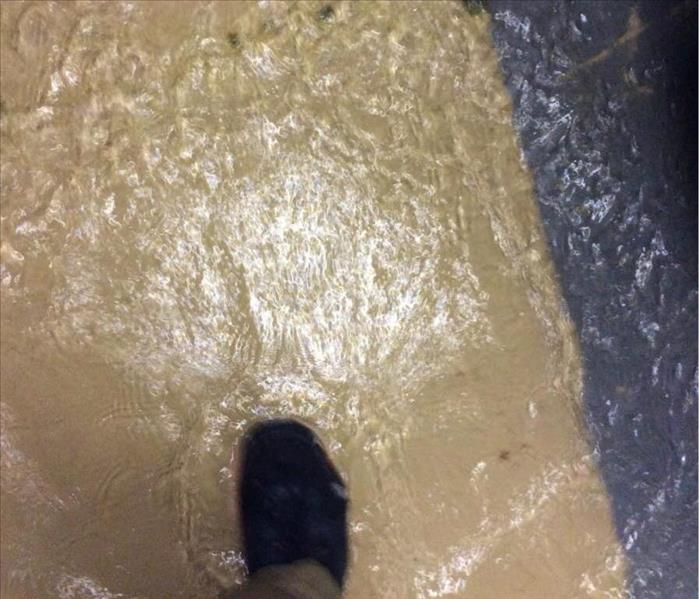 Preparing for a flood would have kept the contents of this home from being soaked and ultimately having to be discarded.
Preparing for a flood would have kept the contents of this home from being soaked and ultimately having to be discarded.
Knowing that flooding and storm damage is a potential threat, there are preventative steps you can take to minimize any future damage.
First, don’t forget to do your spring cleaning. Our homes, and especially our basements, can easily become cluttered with things we don’t even need. Better to clean them out once a year when the weather is nice. If flooding does happen, you’ll be glad that excess clutter is gone.
Second, get your belongings off the floor and up on shelves. Boxes piled up on the floor can quickly become an awful nightmare once water starts to rise. However, if your items are already sorted out on shelves above the water, it’s one less thing to have to deal with. For any low hanging shelves, metal and plastic are recommended rather than wood as they better survive potential water damage.
Finally, make sure you have enough ventilation and keep the air circulating. Potential mold growth will depend on a number of factors, including moisture level, temperature, and the presence of wood and paper materials on which they can feed. Running a dehumidifier can also help remove excess humidity from the affected environment.
If you do require professional water damage restoration services, the professionals at SERVPRO of Eatontown / Long Branch offer 24-hour emergency service. We’re a locally owned and operated company here in your community providing the highest caliber water inspection, extraction, drying, and restoration equipment and service. Call us now at (732) 784-4082.
Groundwater Basement Flooding
3/29/2018 (Permalink)
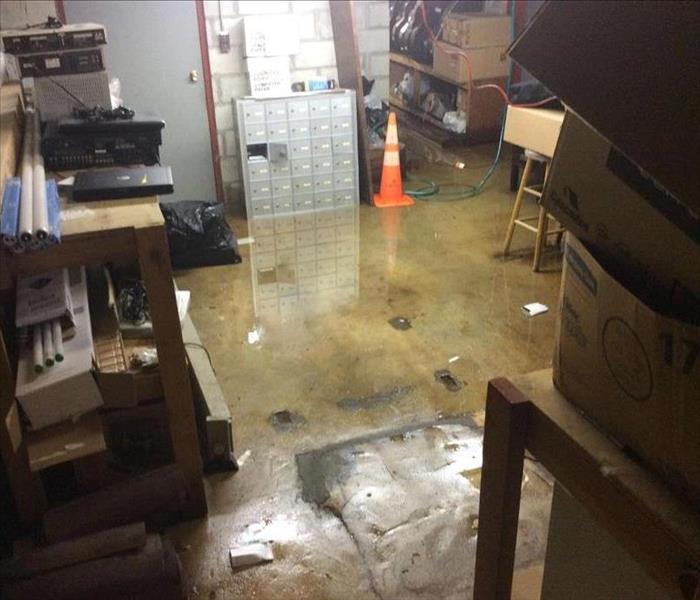 Water in a basement needs to be extracted and dried out as soon as possible.
Water in a basement needs to be extracted and dried out as soon as possible.
Groundwater flooding is basically water in your basement caused by seepage or flow through the walls or foundation floor.
According to State Farm Insurance, there are four common sources of water entering basements. Each source has its own specifics and requires its own course of action.
Surface water running down foundation walls.
If this is the first instance of water problems in your basement, the first thing to check for is surface water draining down next to the foundations. Water coming in at one location or only at the exterior foundation wall indicates surface water problems. Here are some things to look for once you get outside.
- Overflowing gutters: leaves
- Overflowing gutters: downspouts
- Downspout distance
- Pavement slope
- Sealant
- Landscape slope
- Irrigation
Groundwater in water-saturated soils being pushed into the basement by hydrostatic pressure.
If no surface water sources are found, then the source of the water is likely subsurface groundwater under hydrostatic pressure. When the groundwater levels outside the basement rise above the level of the floor, the basement acts like a boat in a pond. If a boat is sitting in water, water will leak in through any open cracks or holes. It works the same way with a basement. Hydrostatic pressure can push water through hairline cracks.
Unfortunately, subsurface groundwater problems are more difficult and more expensive to fix than surface groundwater problems.
Storm sewer water from the municipal storm sewer system backing up into the home's existing perimeter foundation drain and leaking into the basement.
If you have an older house within town and the house has a basement with no sump pump, it is likely the perimeter foundation drain system connects directly into the city storm sewer system. If the level of the basement is below the street level, there is the potential of storm water backing up in the city storm sewer system and being pushed into the perimeter foundation drain system. This can saturate the soils around the house at the basement level with storm water under hydrostatic pressure, causing water to leak in.
- Underground springs
- Storm water backing up
- Sewer water backing up
Sanitary sewer water from a clog in your home's sewer line. If there is a clog in the municipal sewer line, or the combined municipal storm/sanitary sewer system backing up into the home's drain system, it can cause sewer water to come up through sink drains and floor drains on lower levels.
Whatever the cause of water in your basement, remember it is important to have it dried out as soon as possible by a professional. SERVPRO of Eatontown/Long Branch is available 24/7, and will be able to get to your water damage quickly.
Hot Water Heaters: What to Know
2/22/2018 (Permalink)
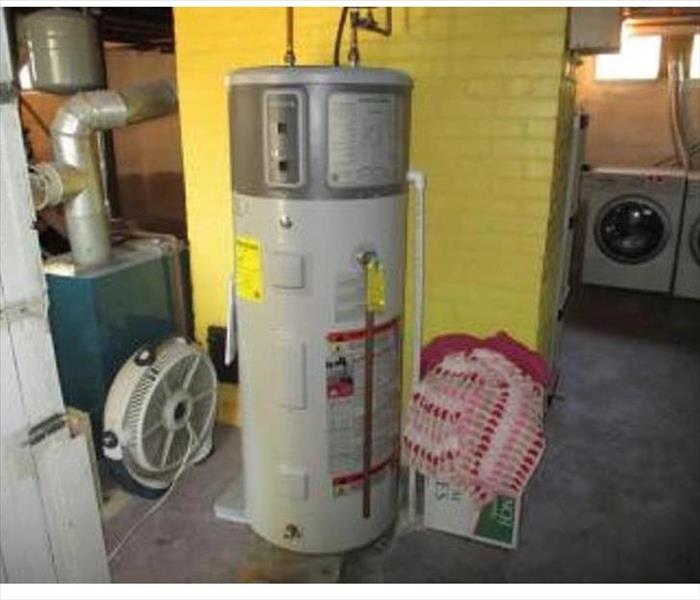 Homeowners should be aware of hot water heater maintenance and replacement.
Homeowners should be aware of hot water heater maintenance and replacement.
Water heaters are one of those appliances that you use frequently, but always seem to forget they’re around. Oftentimes homeowners are surprised in the middle of the night or after coming back from vacation to find water everywhere. A broken water heater can leave over 50+ gallons of water all over your house, depending on how big it is.
How can you tell if it’s time to change your water heater? There are definitely signs.
- On average, your gas hot water heater should last anywhere between 8 to 12 years, while an electric model will last a bit longer at 10 to 15 years. If your water heater is getting up in years, it may be time to replace it before it breaks.
- Tinted water coming from your hot water tap means there may be rust in your water heater, which is a possible indicator your hot water heater is showing signs of wear and may start to leak.
- Gurgling or popping noises coming from your water heater are caused by the buildup of hard water sediment heating up and exploding inside your water heater tank.
- Look around the base of your hot water heater for dampness. This may be a symptom of a slow or intermittent leak.
- If you have no hot water while using your hot water tap, it may be a sign that your water heater needs to be checked out.
- If you see a puddle around the base of your hot water heater, immediate action should be taken to replace it.
Remember, prevention and being prepared could save you thousands of dollars in the long run. But if you need us, the professionals of SERVPRO of Eatontown/Long Branch are available 24/7/365, and will have your home cleaned up and restored “Like it never even happened.”
Water Damage 101
12/29/2017 (Permalink)
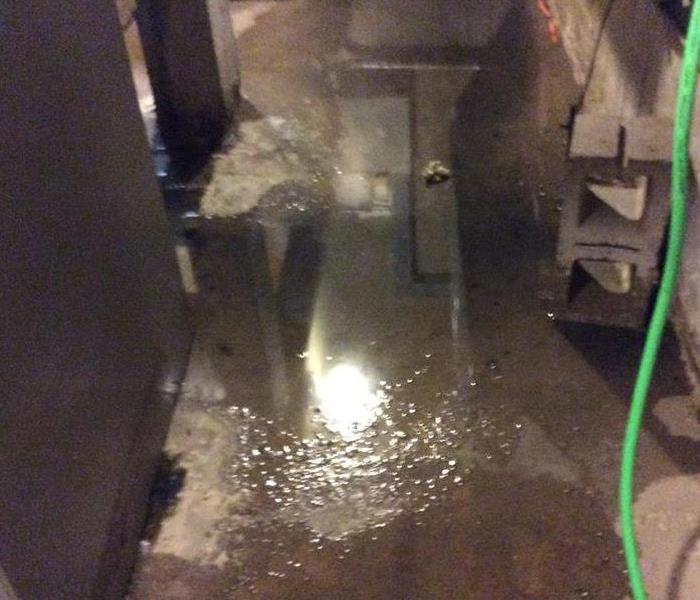 Standing water needs to be mitigated quickly before it has the chance to turn into blackwater.
Standing water needs to be mitigated quickly before it has the chance to turn into blackwater.
According to Wikipedia, wastewater is any water that has been affected by human use. But did you know that there are different grades of wastewater? Should your home be affected by water damage, it is imperative to act quickly to mitigate damage and prevent further damage such as mold growth.
CLEAN WATER
Floodwater that does not pose an immediate health threat is known as clean water. Clean water floods can result from malfunctioning appliances, toilet holding tanks, and melting snow and rainwater. Clean water home floods are generally safe for you to clean up yourself, but remember--time is an important factor. Standing clean water can become greywater if left untreated.
GREYWATER
Greywater refers to wastewater that is not contaminated with fecal matter. As far as household wastewater goes, greywater could include water from bathtubs and showers, appliances such as dishwashers, a weather event, an overflowing plumbing fixture or appliance or even a broken pipe.
When flooding occurs, it can saturate carpeting, furniture and drywall. If you experience a home flood with greywater, wear protective gear, and keep children and pets away from the flooded area. If the flood is extensive, such as several inches of water in the basement, it is advisable to hire professionals to safely clean up and decontaminate the area. Cleanup must begin as soon as possible as greywater can become blackwater if left untreated.
BLACKWATER
Blackwater is wastewater contaminated with human waste, flood water, or water contaminated with chemicals.
Blackwater floods are the most dangerous and the most destructive, and must be cleaned and mitigated immediately. Because of the unsanitary conditions of the water, items such as carpets, upholstery and drywall are often unsalvageable. Contact with blackwater can cause illness in both humans and pets.
Having water damage in your home is never a pleasant experience, and oftentimes it is destructive, and disruptive - affecting multiple rooms, floors, levels – of a home, office or multiple dwelling. Knowing whom to call and when could mean all the difference in keeping contamination and damage to a minimum.
Remember that you can call SERVPRO of Eatontown/Long Branch twenty-four hours a day, 365 days year. We will be there to survey and clean up your water damage quickly and get you back to your normal routine as quickly as possible.
Avoiding Winter Water Damage
11/9/2017 (Permalink)
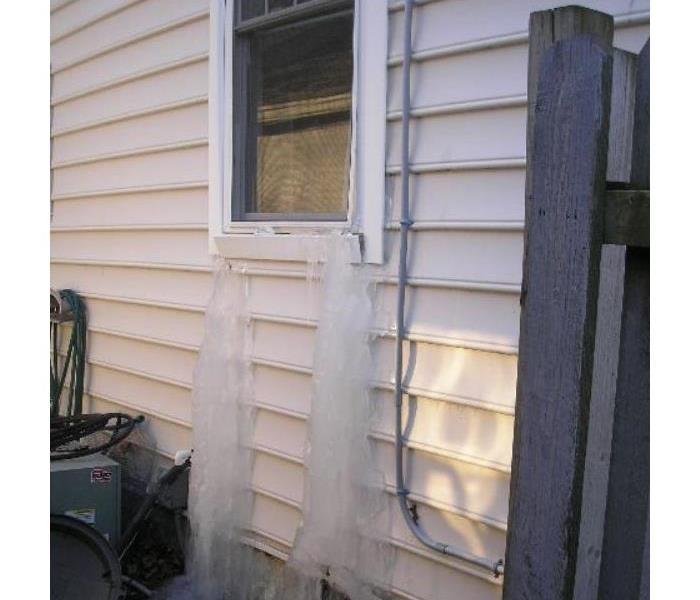 The water that flowed out of this window and froze was caused by an unprotected pipe that burst.
The water that flowed out of this window and froze was caused by an unprotected pipe that burst.
In Monmouth County, cold winter weather can usually come at us in a snap after a warmer, summer-like autumn. Because water expands when it freezes, pipes are especially susceptible to crack and burst from the resulting excess pressure.
That is why it is so important to make sure that you take the steps to prepare your house – especially your pipes, for the freezing temperatures.
Following are tips to get your house ready:
OUTDOORS:
- Wrap outside faucets.
- Caulk around pipes where they enter the house.
- Disconnect garden hoses.
- Drain in-ground sprinkler systems.
INDOORS:
- Let a stream of water run if the temperatures dip below freezing.
- Open cupboard and vanity doors in the kitchen or bathroom.
- Keep the thermostat set to the same temperature both during the day and at night. By temporarily suspending the use of lower nighttime temperatures, you may incur a higher heating bill, but you can prevent a much more costly repair job if pipes freeze and burst.
- Shut off and drain your water system if you are leaving the home for several days or more, and set your thermostat a temperature no lower than 55° F.
IF YOU DO COME HOME TO FROZEN PIPES, THESE TIPS CAN HELP YOU
- If you turn on a faucet and only a trickle comes out, suspect a frozen pipe. Likely places for frozen pipes include against exterior walls or where your water service enters your home through the foundation.
- Keep the faucet open. As you treat the frozen pipe and the frozen area begins to melt, water will begin to flow through the frozen area. Running water through the pipe will help melt ice in the pipe.
- Apply heat to the section of pipe using an electric heating pad wrapped around the pipe, an electric hair dryer, a portable space heater (kept away from flammable materials), or by wrapping pipes with towels soaked in hot water. Do not use a blowtorch, kerosene or propane heater, charcoal stove, or other open flame device.
- Apply heat until full water pressure is restored. If you are unable to locate the frozen area, if the frozen area is not accessible, or if you cannot thaw the pipe, call a licensed plumber.
- Check all other faucets in your home to find out if you have additional frozen pipes. If one pipe freezes, others may freeze, too.
Should you ever have a problem with water due to bursting pipes or any other reason, calling SERVPRO of Eatontown/Long Branch will get your home back to normal “Like it never even happened.”
Water Restoration: 5 Ways to Deal with Water Damage
10/13/2017 (Permalink)
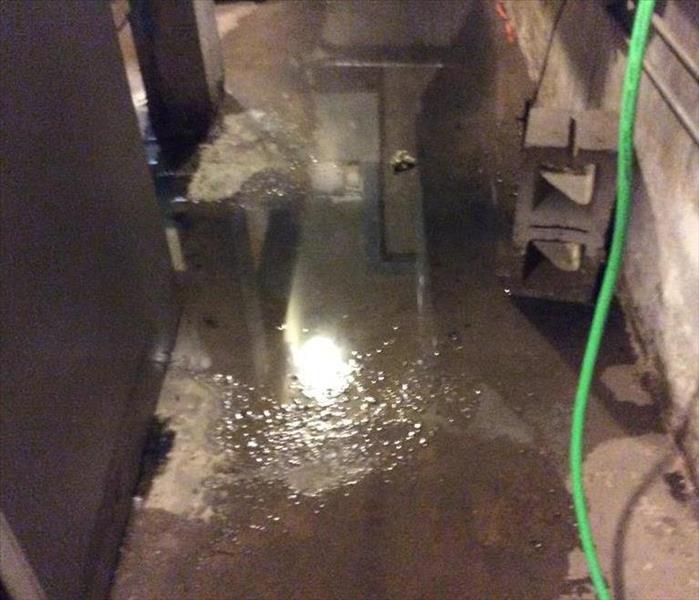 Standing water can create issues from water flow obstruction to mold.
Standing water can create issues from water flow obstruction to mold.
As a homeowner, water damage is always a cause for concern. When water damage does strike, it’s important to know how to handle the situation with efficiency and ease. Effective water damage restoration comes with knowing that the situation is urgent and calling the professionals immediately, however, there are a few things each and every homeowner can do to minimize the damage.
Prevent It
The best path towards successful water damage restoration is to not have to restore anything at all. One of the most beneficial things a homeowner can do is be informed. In short, know your home!
- Know where your water main valve switch is located. This is really important. Don’t be afraid to shut it off when you go away for long periods of time.
- During the winter, disconnect your hoses. This prevents standing water from forming and creating an issue where your water flow becomes obstructed. Bursting pipes are no fun!
- Maintain the hoses in your home. From the washing machine to under the sink, make sure you upgrade your hoses regularly to avoid leaks.
- Measure your water pressure. Hoses and pipes can only handle so much and checking the pressure that is running through them can save you a huge headache. You can buy a pressure gauge at Home Depot or Lowes that will do the trick.
Safety First
Any disaster, small or large, comes with the risk of safety. First, make sure everyone is safe and while cleaning up the damage wear gloves, waterproof footwear, and protective gear. Additionally, be mindful of mold and bacteria, exposure to them can be very unhealthy.
Create Airflow
SERVPRO’s professionals understand how important it is to create airflow in a water damage emergency and their team is second-to-none when it comes to water cleanup and restoration. As a homeowner, we recommend utilizing any fans or dehumidifiers you have in your home until the pros arrive. This helps prevent bacteria and microbial growth from forming.
Smart Storage
One of the smartest preventative measures you can take is to keep a close eye on how you store your belongings and items within your home. Items and boxes stored at floor level are a target for damage, should a water emergency occur. Utilizing plastic or metal shelves for storage can prevent your items from taking on water damage. Avoid wood and particleboard if possible.
Plastic storage bins can provide an excellent way to store items as well. And even better, they’re cheap! Make sure the tops are secure and store them a few feet off the ground.
Isolate the Damage
If disaster does strike, you will want to remove the affected items right away. Separate water-logged items and place them in an area where they can dry. This will allow you the ability to move around the water-filled area with ease and create airflow that can help reduce water damage quickly.
Call the Pros
Dealing with water restoration and damage can be incredibly time consuming and frustrating. We suggest you call the professionals immediately so they can guide you through the process. The SERVPRO team is experienced and knowledgeable and will be able to get you back on track in no time. We are here to serve you!
If you need to reach us feel free to contact us through our site form or call us at (732) 858-5416.
Winning the War Against Wind and Water During the Colder Months
9/25/2017 (Permalink)
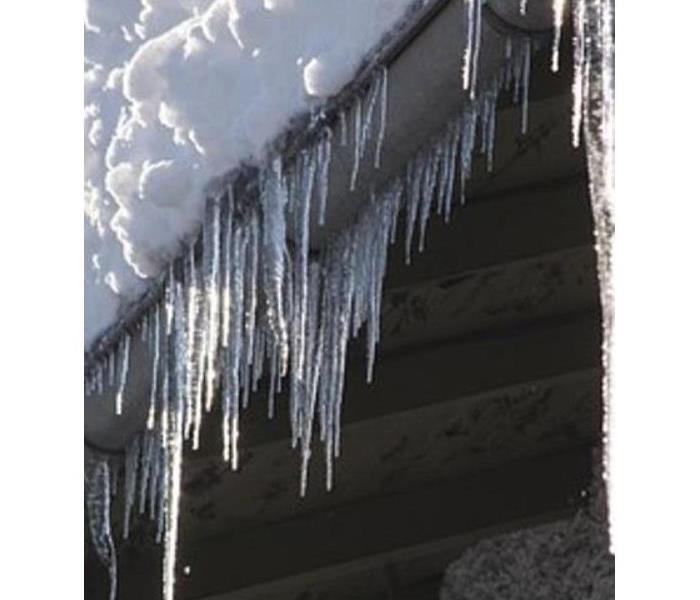 Icicles forming on your gutters can cause structural damage due to melting and refreezing water.
Icicles forming on your gutters can cause structural damage due to melting and refreezing water.
It seems most of the heavy-hitting storms happen in the fall, followed by brutal winter blizzards and nor’easters. Your adversaries during this time are the two legendary elements: Wind and Water. At full force, the wind will scatter leaves and tear off the sturdiest limbs; water will flood and wash away. The damage they can cause can be mind-boggling, resulting in physical injury and death, and property destruction.
Homeowners must be mindful of the impact that powerful storms and weather systems to their property and their loved ones. Decisions must be made in a timely manner to get ahead of the extremes of the season. The following are suggested remedies for possible issues that will come up as the seasons change and the weather gets colder.
Keep Drains and Gutters Clear
After a major rainfall, rain pours from your roof and pools around your property and leaks into your basement. A major reason is leaves and branches clogging water drainage on the street or around your house. When not raked away from drains, leaves and branches will clog them. Rake the leaves and clear treefall from your property.
The same applies for snow. Snow mounds on the street may be slow to melt and get stuck in a cycle of re-freezing and will block any drains. If it’s on your property—or if you’re feeling neighborly when the department of public works has left the job to fate—break it up and keep it clear.
As for the gutters around your roof, it’s best to contact a professional gutter cleaning service to clear out leaves and debris that could choke your gutters. If left unattended, rain will flow unhindered to leak down into your property, potentially flooding your basement. During the colder months, moisture in the gutters will freeze and weigh them down. They could come crashing down around you and cause injury as well as property damage.
Another tactic to aid with drainage is to consult with a landscaping service to design your property to move water away from your home, and have plantings to prevent soil erosion.
If you have a concern about the basement flooding, your house should have a working sump pump system or a French drain system to prevent seepage or drain collected water. If your basement does take in water and you are able to drain it out, you should set up a de-humidifier to dry it out to prevent mold and mildew growth.
Seal Potential Leaks & Gaps
It’s almost inevitable that leaks will develop in a house, from top to bottom, owing to long-term exposure to the elements, construction concerns or animals nesting. As it gets colder and wetter, those leaks could become more than just a nuisance. When a leak entry point freezes and re-freezes, the gap will expand and allow more water in.
If the leak is coming from the roof, you will need to locate where the leaks are coming from and seal them. You can do it yourself, but if it looks like a bigger job, locate a roofer.
Windows can also be a source for leaks. Just like the roof it will take some detective work to locate where water is coming in–you may have to check for cold air as well. Once you find it, you’ll have to caulk around where the break is.
Clear Away Sick Trees and Loose Branches
The day after any powerful storm will find a landscape littered with fallen branches and downed trees. Some of those trees will have a crushed house underneath. Others will lean on power lines. One of the reasons for the trees to be uprooted may be that the ground was so sodden the roots couldn’t maintain their grip, owing to poor drainage.
If you have trees on your property it would be in your best interest to hire an arborist or tree service to check your tree’s health. Most branches and fallen trees were weak and sick before a storm, and only needed the right gust to send branches flying and trunks to topple.
If you do have sick trees, then you should have them and whatever weakened limbs removed. It’s recommended to get a professional service to do it. DIY only works if your experienced and know how to handle the tools to do the job.
Should you need professional assistance, SERVPRO has the professionally trained staff to handle your post storm clean-up. Regular property maintenance can make the difference between a rough weather season that’s manageable and one full of hazards, costly financially—and in life and limb. Staying several steps ahead of the damage caused by wind, rain, ice and snow can make for a safe and secure rest of the year.
Winter Ice Dams: Cause, Effects, and Prevention
1/25/2016 (Permalink)
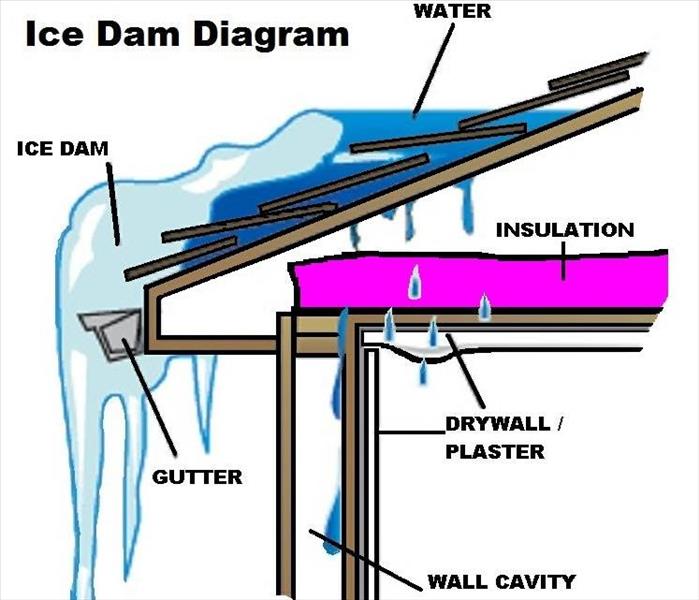
What Causes Ice Dams?
Ice dams form when melting ice and snow refreeze above the eaves of your roof and subsequent melting backs up under the shingles. This causes interior leaks and water damage to interior walls and ceilings.
Preventing Ice Dams
Proper ventilation, drainage and insulation are the only ways to prevent ice dams and can be achieved in the following ways:
- Make sure your gutters are clear of leaves and debris
- Check and seal places where warm air could leak from your house to the attic: vent pipes, exhaust fans, chimneys, attic hatches and light fixtures are all possibilities
- Inspect, or have your roof and attic inspected for proper ventilation and insulation
- Look for signs of inadequate ventilation: rust spots, rusty nails or a mildew smell are all signals that moisture has formed on the inside of your roof
- If you have soffit vents in your eaves, make sure they are not blocked and insulation surrounding them is secured so that air can flow easily
- Keep snow from accumulating on the lower three to six feet of your roof
Additional Steps
- Install snow and ice slides to prevent ice and snow from "bonding" to the lower roof
- Install a rubberized ice and water shield beneath the roof shingles for the first three to six feet from the eaves up
- Install heating cable along the eaves to melt ice
Removing Ice Dams
- Consult a roofing professional
- Do not use a snow blower, shovel or blowtorch to try to chip, break or melt ice dams
Ice And Cold Can Wreak Havoc On Your Home
3/2/2015 (Permalink)
March is here and winter is still with us in Monmouth County NJ. From Sea Bright to Long Branch, Red Bank and Eatontown, many homeowners have experienced water damage from frozen pipes these past two months. Keep in mind that ice dams can also cause water to come into your home from the outside elements. Luckily, SERVPRO of Eatontown/Long Branch is here to help 24 hours a day. Our experienced crews can tackle any type of water or fire damage in your home. Call us at 732-578-9888.
Avoid Winter Water Damage
1/28/2015 (Permalink)
With ice, snow and cold temperatures across the Jersey Shore, SERVPRO of Eatontown/Long Branch reminds you take the steps needed to avoid major flooding problems...
OUTDOORS:
- Wrap outside faucets
- Caulk around pipes where they enter the house
- Disconnect garden hoses
- Drain in ground sprinkler systems
INDOORS:
- Let a stream of water run if the temperatures dip below freezing
- Open cupboard and vanity doors in the kitchen or bathroom
- Shut off and drain your water system if you are leaving the home for several days or more.





 24/7 Emergency Service
24/7 Emergency Service




















